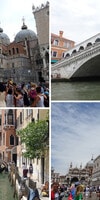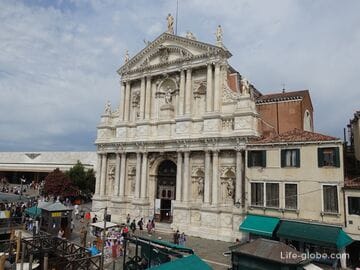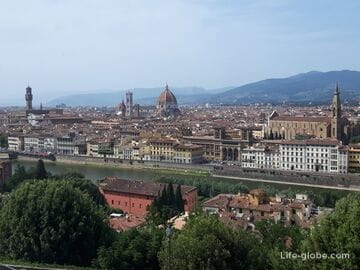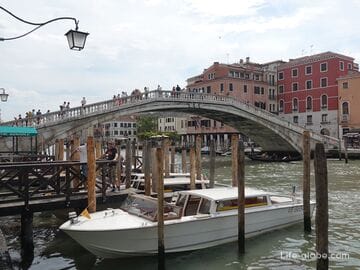Venice is certainly beautiful, unusual and colorful. It is a city on the water, a city surrounded by water; a city of hundreds of islands, canals and bridges.
Venice is also famous for its abundance of palaces, basilicas and museums with works by outstanding masters.
Due to its urban features and rich artistic heritage, Venice is considered one of the most unusual and beautiful cities in the world, declared a UNESCO World Heritage Site.
This article presents a list (with photos, descriptions, addresses and websites) of the main and most striking sights and museums of Venice, which are worth visiting in the first place or if little time is allocated to the city.
You can visit the sights and museums of Venice, including the top ones, as well as enjoy the city from the water of numerous canals and travel outside the historical island part of Venice both independently and with excursions
All excursions in Venice and outside the city center
The main sights and museums of Venice
All the main sights and museums of Venice are concentrated in its island historical center, which consists of many islands separated by canals and connected by numerous bridges over these canals.
And it is not surprising that the main attraction of Venice are
Canals of Venice (Grand Canal and Rialto Bridge)
There are only four canals in the historic island Venice, designated as "canale". These are: the Grand Canal (Canal Grande), the Cannaregio Canal (Canale di Cannaregio), the Giudecca Canal (Canale della Giudecca) and the Scomenzera Canal (Canale della Scomenzera). There are also many small channels called "rio" (rio) and the smallest ones called "rielo" (rielo).
Nevertheless, in a general sense, the common name "canals" is used for all waterways of Venice.
Along the canals of Venice, buildings stretch in dense rows, among which there are residential buildings, palaces, museums, churches and basilicas. Museums, shops, souvenir shops, cafes, restaurants and accommodation facilities (hotels, apartments) are located in the buildings along the canals
Most of the buildings along the canals approach directly to the water, so it seems that they come directly from the waters of the canals.
There are also areas in the city where sidewalks-embankments run along the canals. Learn more about the canals of Venice...
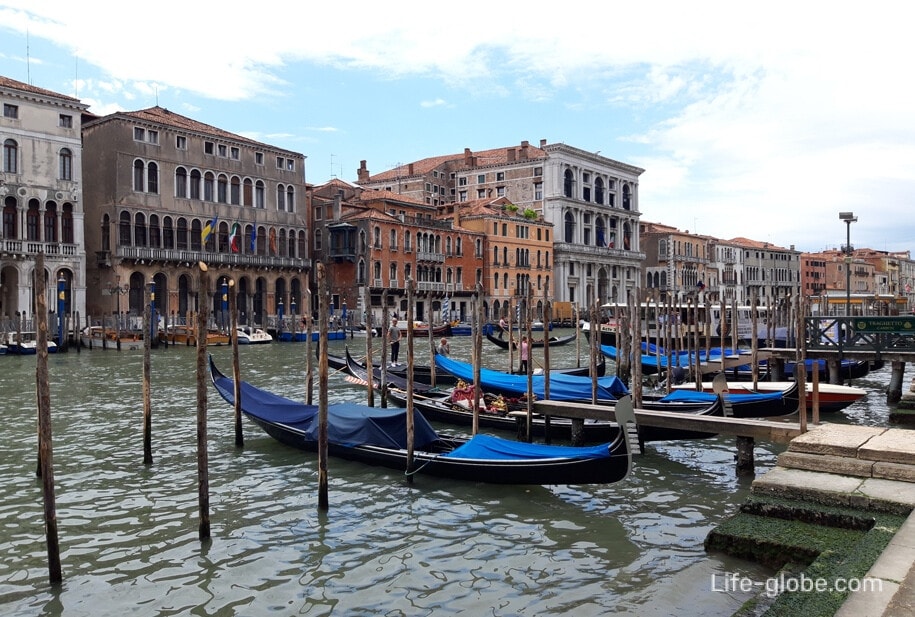
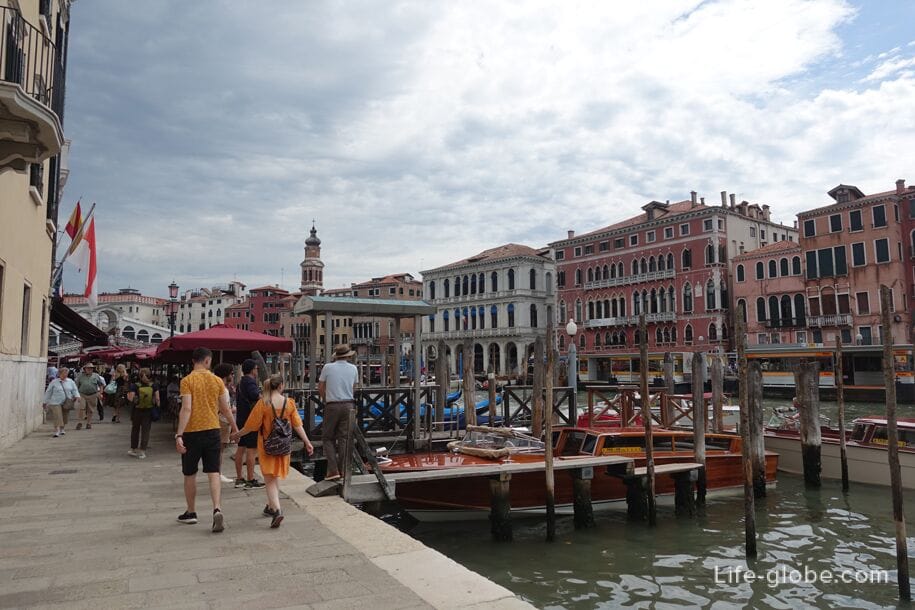
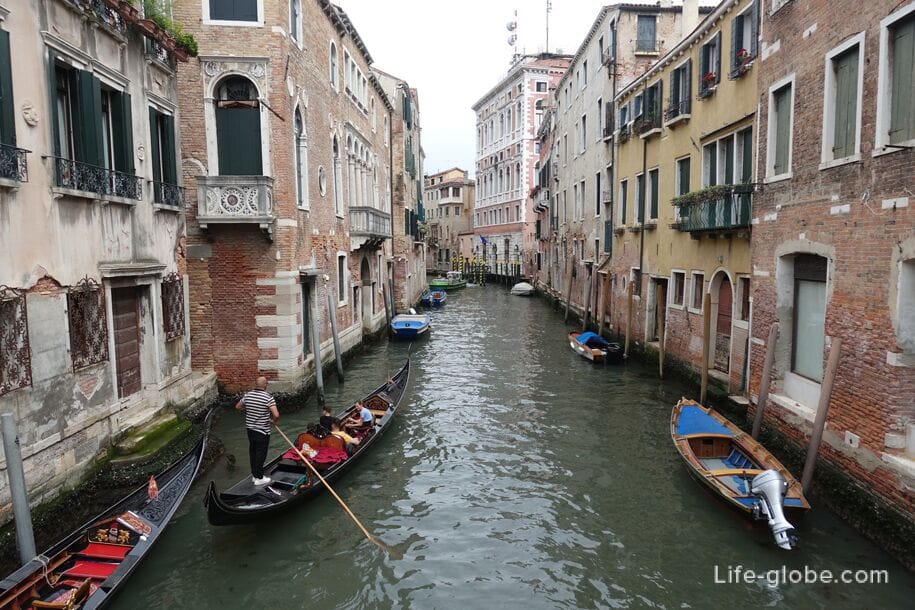
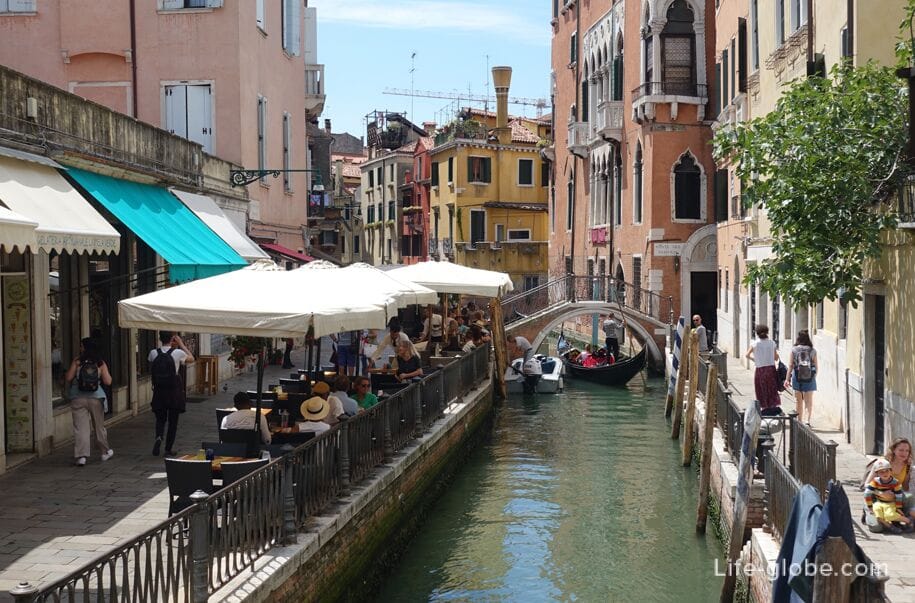
The main, most famous and largest of the channels is the Grand Canal / Grand Canal or Grand Canal (Canal Grande).
The Grand Canal crosses the historical center of the city; starting from the lagoon near the Santa Lucia railway station, it passes through the entire main historical island part of Venice and exits into the San Marco (St. Mark's) basin, thus forming the shape of an inverted letter "S".
There are bridges across the Grand Canal. Along the canal there are unpaved sections of embankments and along the entire canal there are exquisite buildings of various architectural styles, among which there is an abundance of former palaces and mansions, there are also museums, churches and a basilica.
All this creates an unsurpassed ensemble of the channel, the types of which are widely recognized all over the world. Learn more about the Grand Canal...
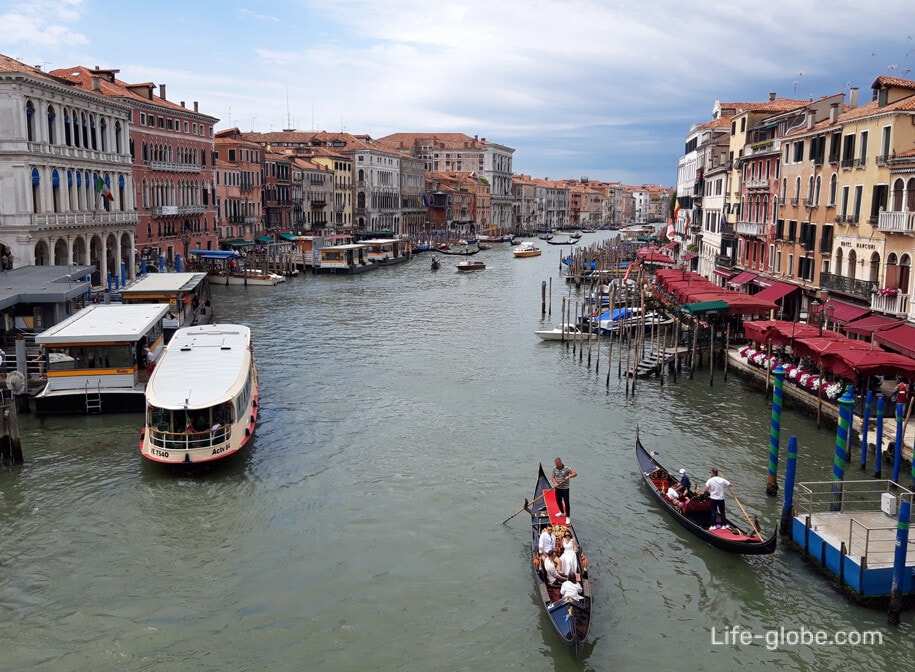
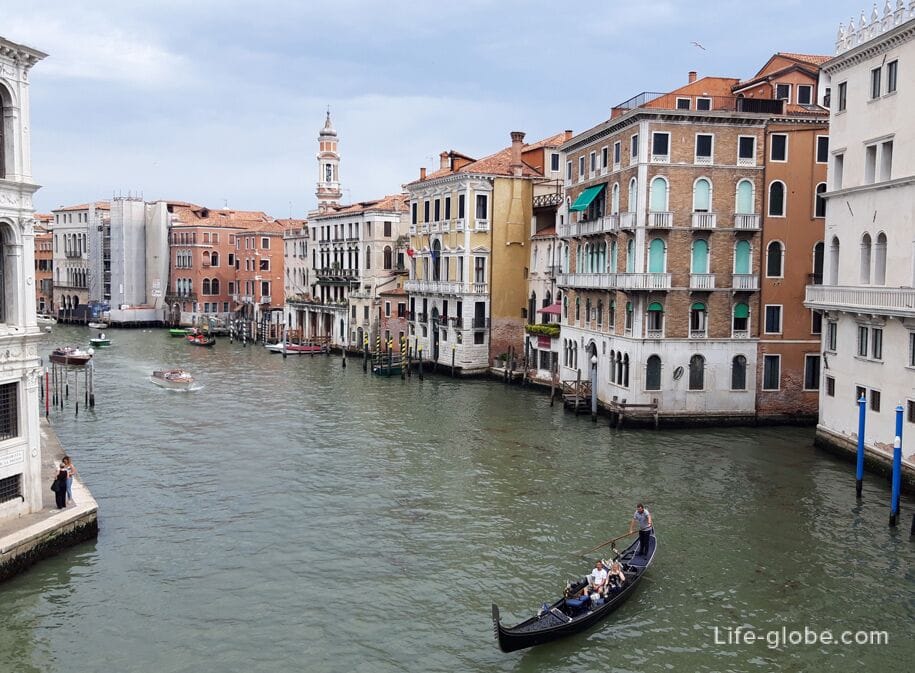
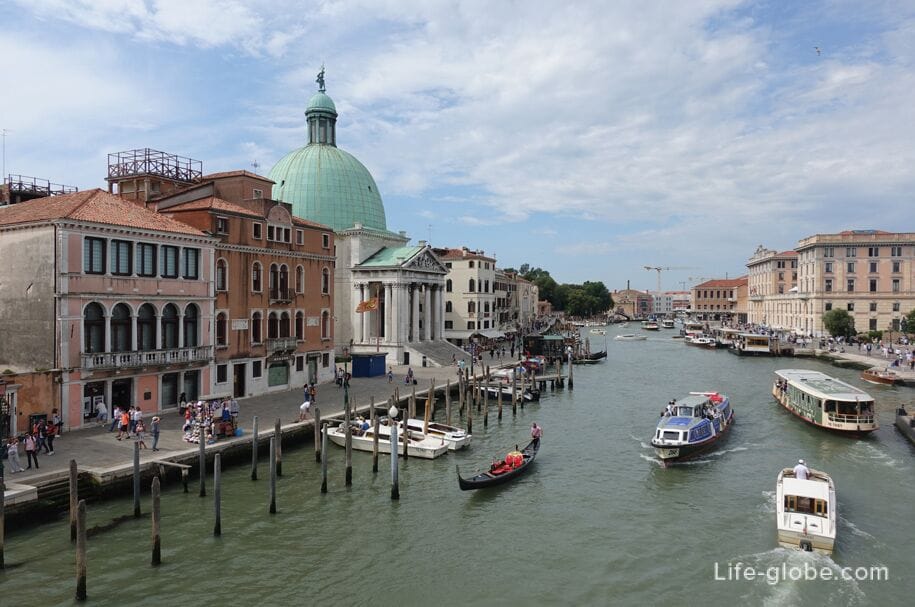
There are four bridges spanning the Grand Canal, the most famous of which is the Rialto Bridge (Ponte di Rialto, Ponte di Rialto), considered one of the symbols of Venice.
It is the oldest of the four bridges across the canal. The current bridge was completed in 1591.
The bridge is made in the form of an arch, has some decorations and architectural railings. There are benches on the bridge, separated in the center by two powerful arches. Between the rows of shops there are stairs leading to the center of the bridge, starting at the edges of the bridge. The shops sell souvenirs, leather and jewelry. More about the Rialto Bridge...
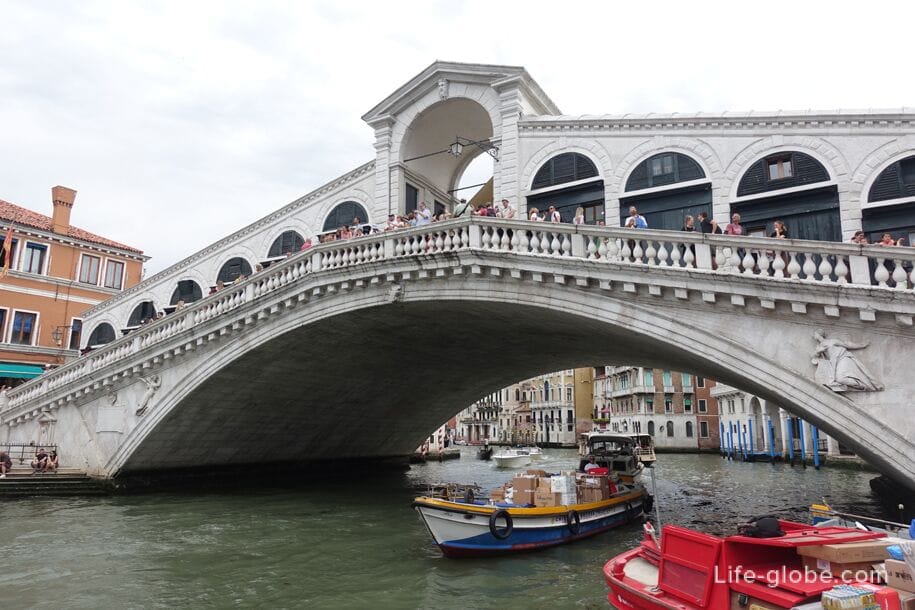
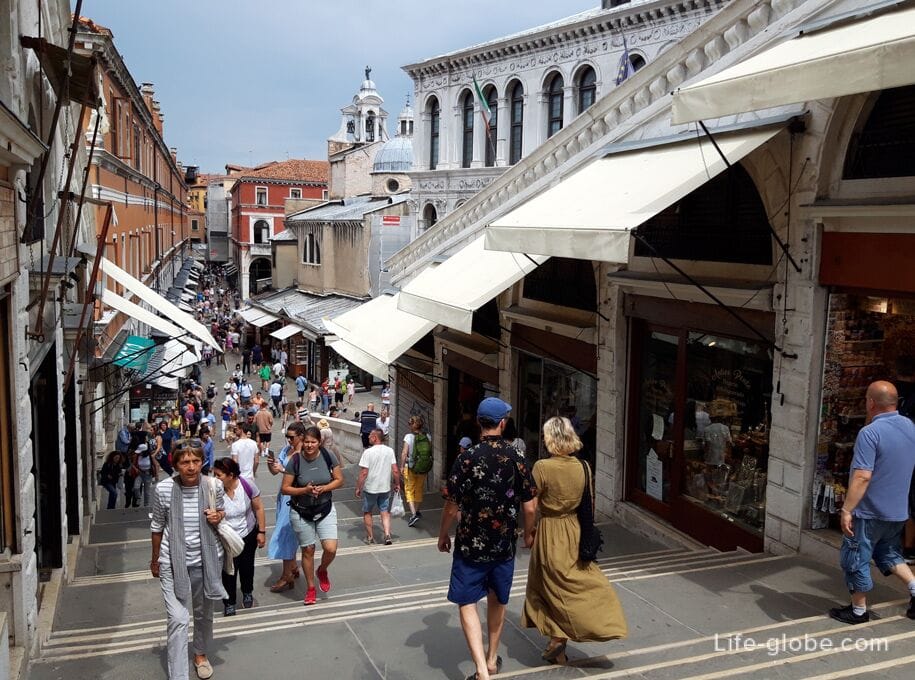
At the waters of the Grand Canal, next to the Rialto Bridge, there is a shopping center "T Fondaco", which has a panoramic terrace "T Fondaco dei Tedeschi" with spectacular views of the canal and part of Venice.
Access to the terrace is free, but the place must be booked in advance online on the website, or directly when visiting the shopping center, if there are free seats.
Website: dfs.com/it/venice.
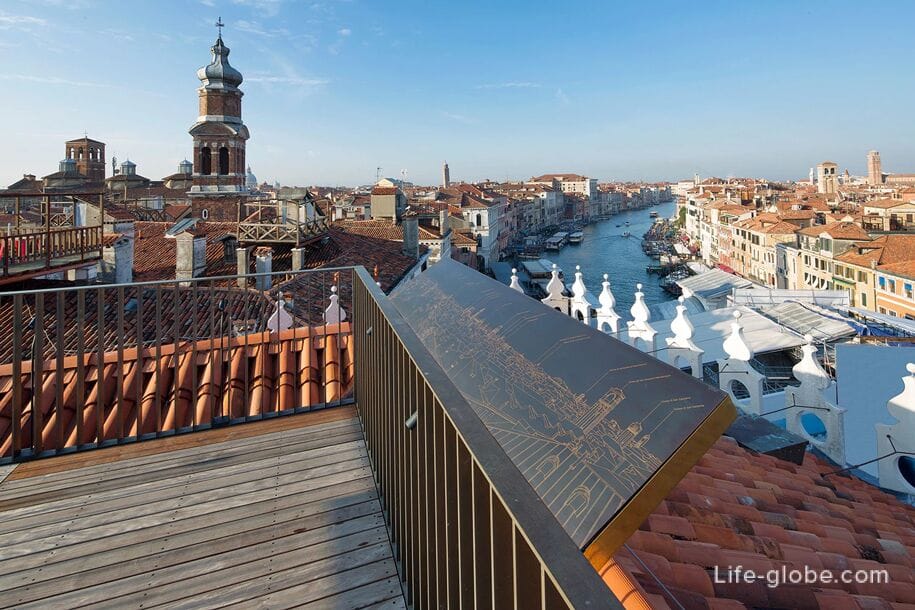
San Marco Square
Piazza San Marco is the main public square of Venice, which is one of the most important monumental squares in Italy, known worldwide for its beauty and architectural integrity.
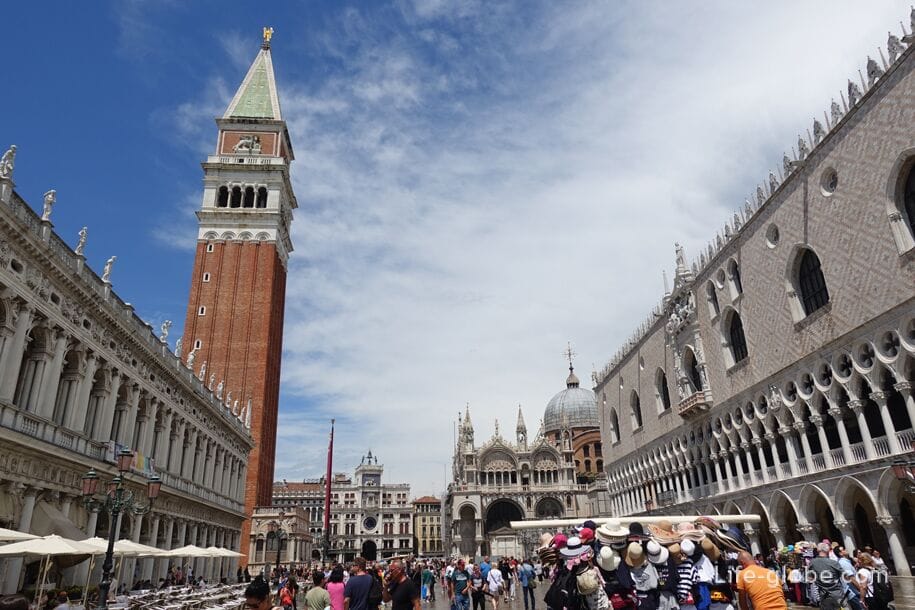
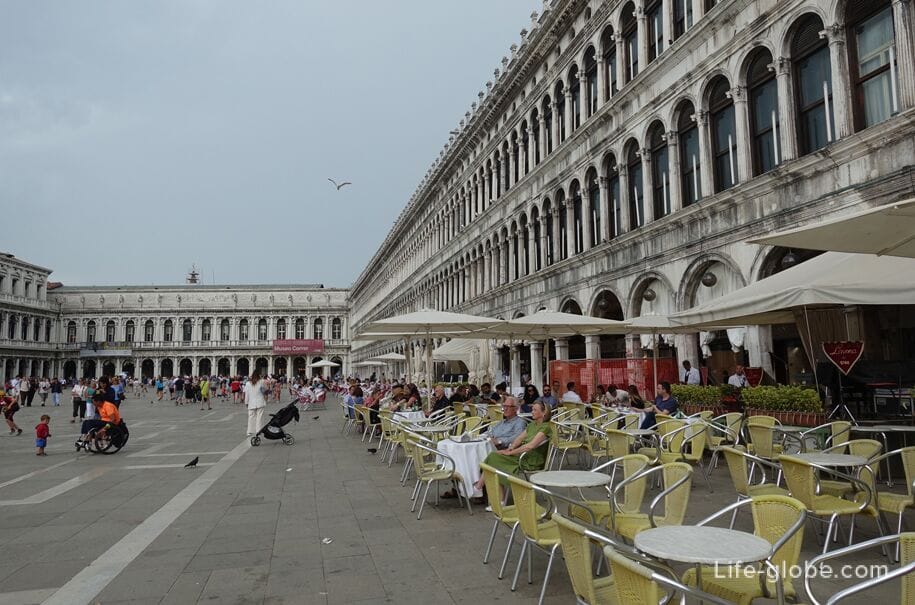
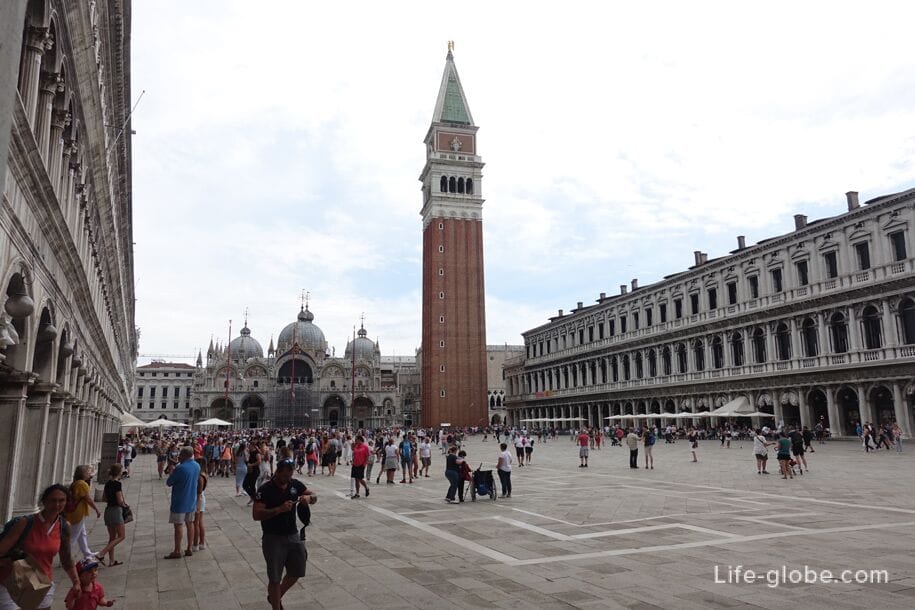
On the square there are
St. Mark's Cathedral (Basilica of San Marco, Basilica di San Marco) is the main church of Venice, which is the city cathedral and the most famous symbol of Venice.
The history of the church began in 828 (829), when the body of St. Mark was transported from Alexandria, Egypt. The modern cathedral was started in 1063.
Today, the exquisite marble facade of the church with domes, mosaics, sculptural and relief decorations makes an unsurpassed impression.
The relics of St. Mark the Evangelist, the patron saint of the city, are kept in the Cathedral of San Marco. The cathedral is also an image of Venetian-Byzantine architecture and attracts attention with mosaics on a golden background, sculptures, a valuable altar and a museum with an outdoor terrace where you can go out and admire the views of St. Mark's Square.
A visit to St. Mark's Cathedral is paid. A visit to the altar space of the cathedral - with an additional fee. A visit to the cathedral museum with access to the terrace - with an additional fee. Children under 6 years old - free of charge.
St. Mark's Cathedral website: basilicasanmarco.it. Learn more about St. Mark's Cathedral and visiting the cathedral...
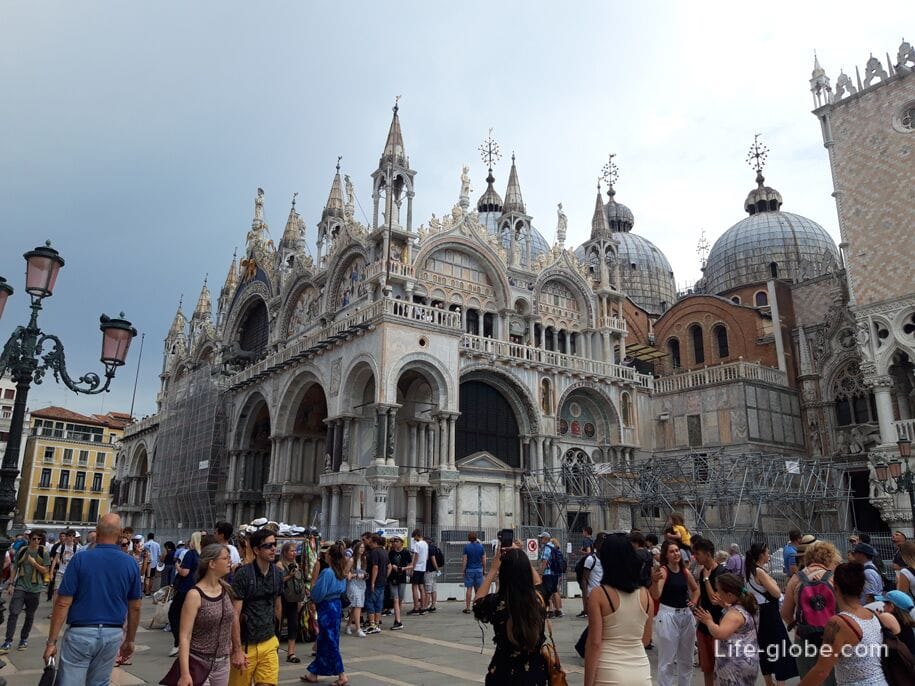
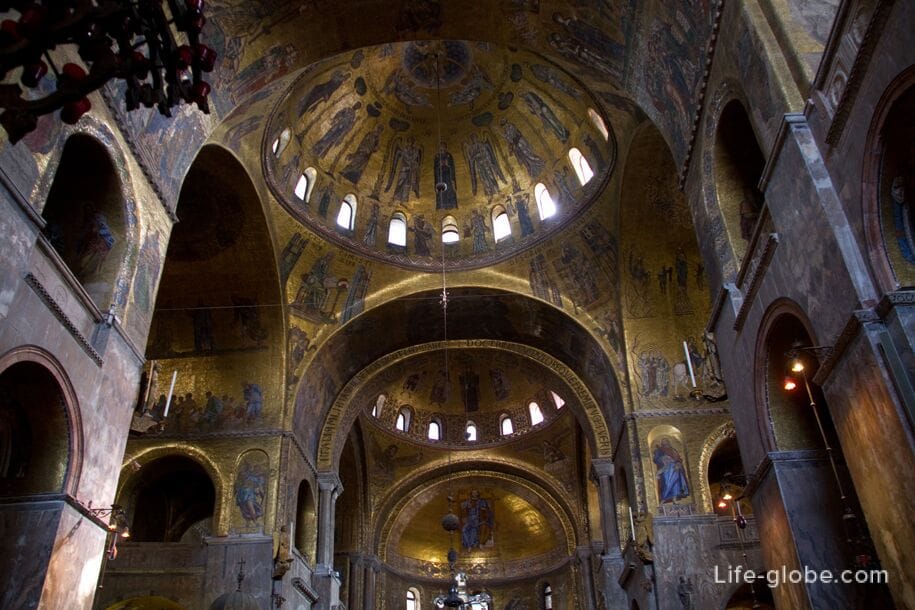
Not far from the main facade of the Cathedral of San Marco there is a high detached bell tower of the cathedral - the bell tower of St. Mark (Campanile of San Marco, Campanile di San Marco).
The Campanile is the tallest building in the historical part of Venice; it has architectural decorations and, in the upper part, a public 360-degree observation deck, which offers breathtaking views of the historic island of Venice and the lagoon from a bird's-eye view.
A visit to the observation room in the bell tower is paid.
At the base of the bell tower adjoins a small loggia called Loggetta Sansovino (Loggetta Sansovino a Venezia), which was built between 1537 and 1549 by the architect Jacopo Sansovino (hence the name). This is a monument of Renaissance architecture, which is decorated with sculptures and it was originally used to meet nobles, communicate with important dignitaries and officials. Learn more about the Campanile of San Marco, the observation deck and the loggia...
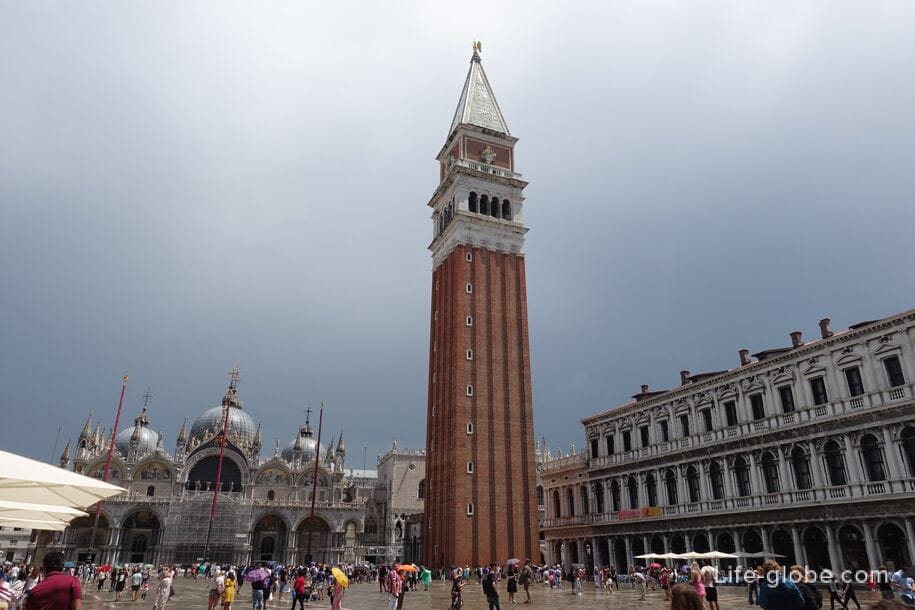
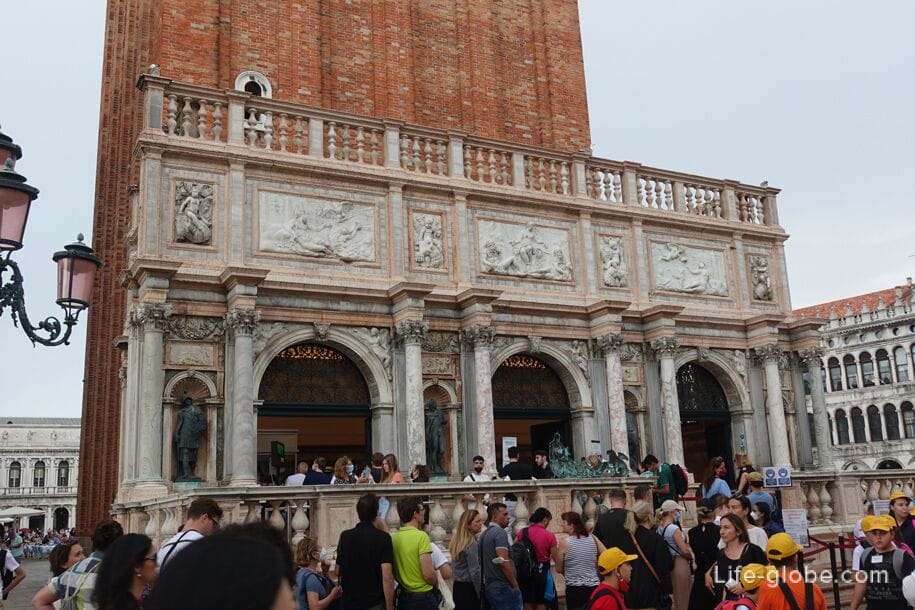

Another outstanding monument on the square is the Doge's Palace or Ducal Palace (Palazzo Ducale, Palazzo Ducale) - the former residence of the Doge (the oldest and highest magistracy of the Venetian Republic), which is a masterpiece of Gothic art, which now houses a museum.
The palace was built between 1309 and 1424, presumably by the architect Filippo Calendario. Subsequently, the palace was expanded; so, in the 17th century, a New prison (Prigoni Nuove) and the Bridge of Sighs (Ponte dei Sospiri) were built, which connected the prison with the Doge's palace.
In the Doge's Palace, you can visit the wings of the palace with galleries, halls, representative rooms and apartments of the Doge, as well as the Bridge of Sighs, prison, armory and secret routes.
In the premises of the palace there are collections of antiquities, as well as temporary exhibitions.
Entrance to the Doge's Palace is paid.
Website of the Doge's Palace: palazzoducale.visitmuve.it. More about the Doge's Palace...
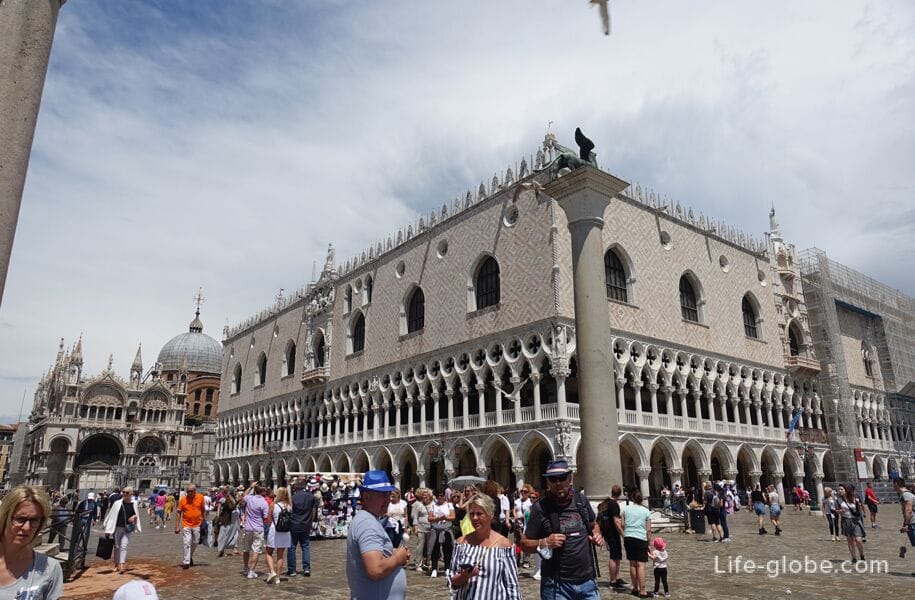

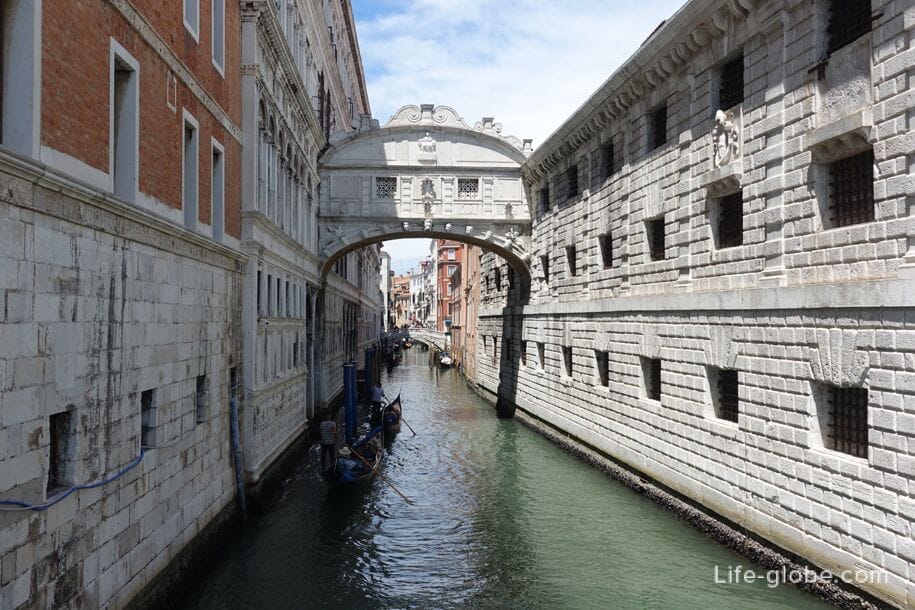

The Biblioteca Nazionale Marciana is the national public and most important library of Venice, which is one of the largest Italian libraries.
The monumental halls of the library are now a museum and can be visited. The halls are located in the historic library building, which looks like loggias with various decorations and sculptures and was started by the Italian architect and sculptor Jacopo Sansovino in 1537.
Marcian Library website: bibliotecanazionalemarciana.cultura.gov.it. Learn more about the Marcian Library, halls and visiting...

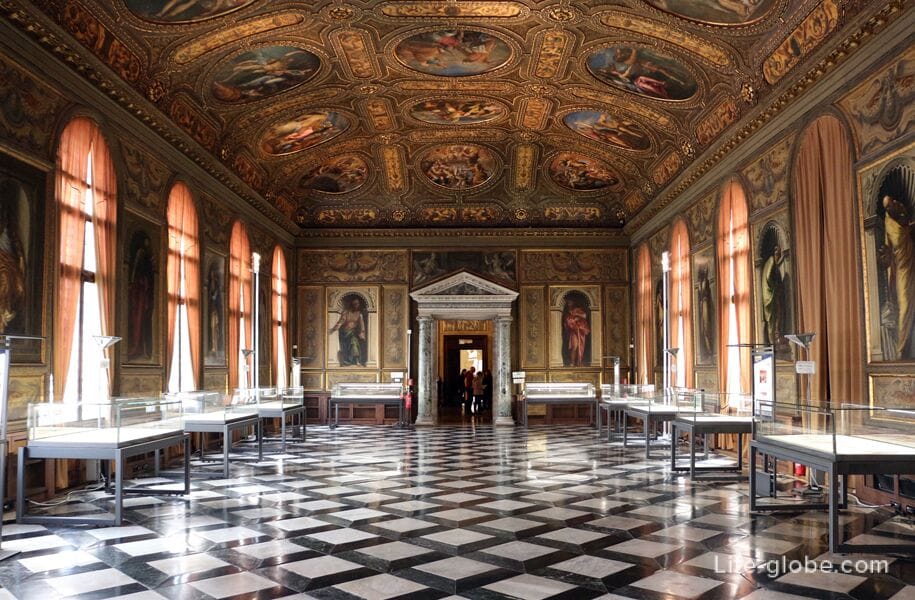
St. Mark's Clock Tower (San Marco Clock Tower) or Torre dell’Orologio (Torre dell'orologio) is a Renaissance building, which is famous for its large clock, sculptural decorations and a bell on the roof.
The tower was built between June 1496 and 1499 to house clocks equipped with automation and complex mechanisms, and to reflect the interest of the Venetian state in mechanical sciences and to show a society that keeps up with the times.
Guided tours are conducted around the tower, during which you can see the clockwork from the inside, as well as go out on the roof and admire the views of the very heart of Venice.
The site of the Clock Tower Museum: torreorologio.visitmuve.it. Learn more about the clock tower, the clock and visiting the tower...
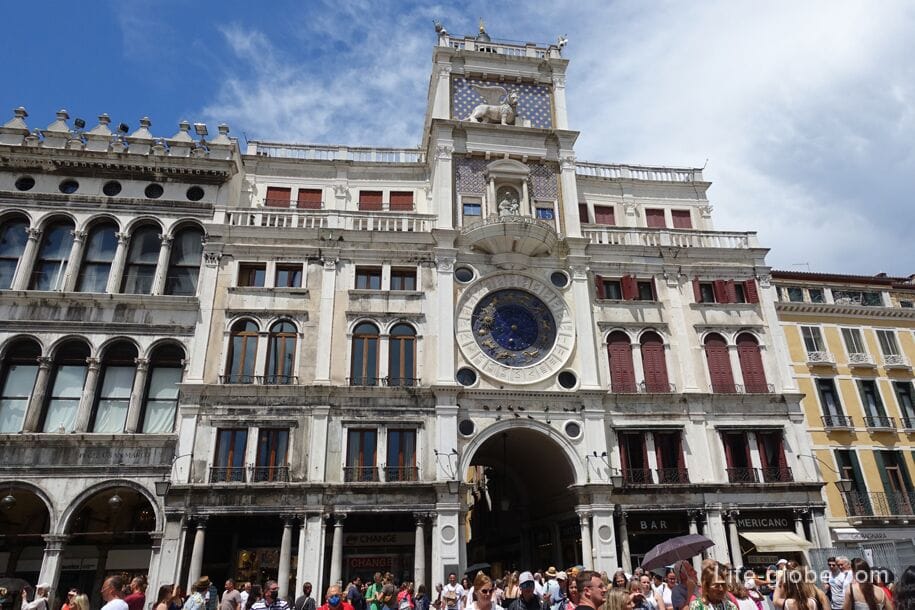
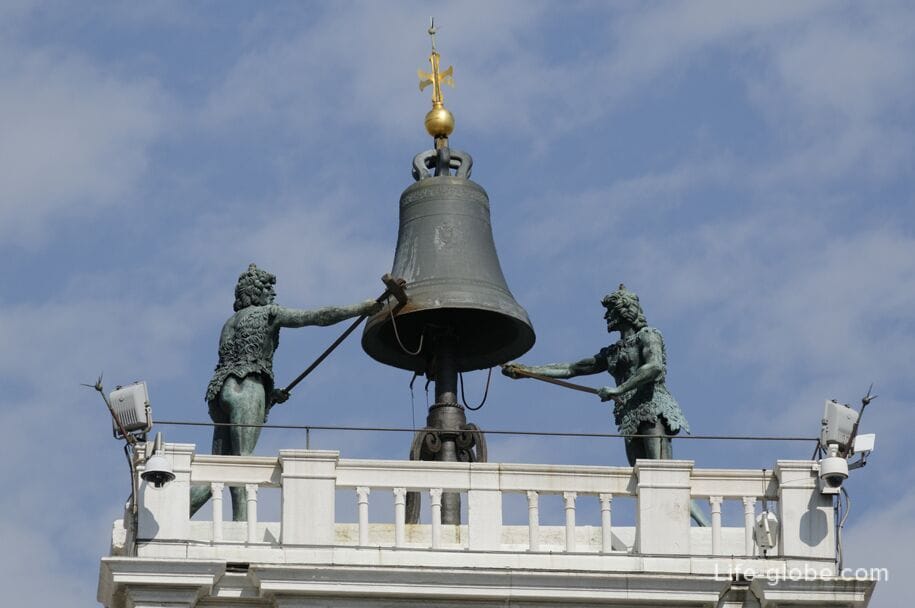
The wings of the former Prosecutor's Office, which surround St. Mark's Square from all three sides and represent a single architectural ensemble, although they were erected at different times, starting from the 16th century.
Today, cafes, restaurants, shops and offices are located in the former wings of the Prosecutor's Offices, there are also:
- Museo Correr, where you can visit the beautiful halls, while seeing frescoes, stucco decorations, old furniture, sculptures, paintings, as well as a "collection of wonders" that evokes the charm of the possible Wunderkammer Lagoon. The museum's website: correr.visitmuve.it;
- The National Archaeological Museum of Venice (Museo Archeologico Nazionale), which preserves and exhibits precious Greek and Roman sculptures, bronze, ceramics, precious stones and coins, inscriptions of Venice and the Republic, along with Egyptian and Assyrian-Babylonian antiquities. The museum's website: archeologicovenezia.cultura.gov.it . More about San Marco Square...
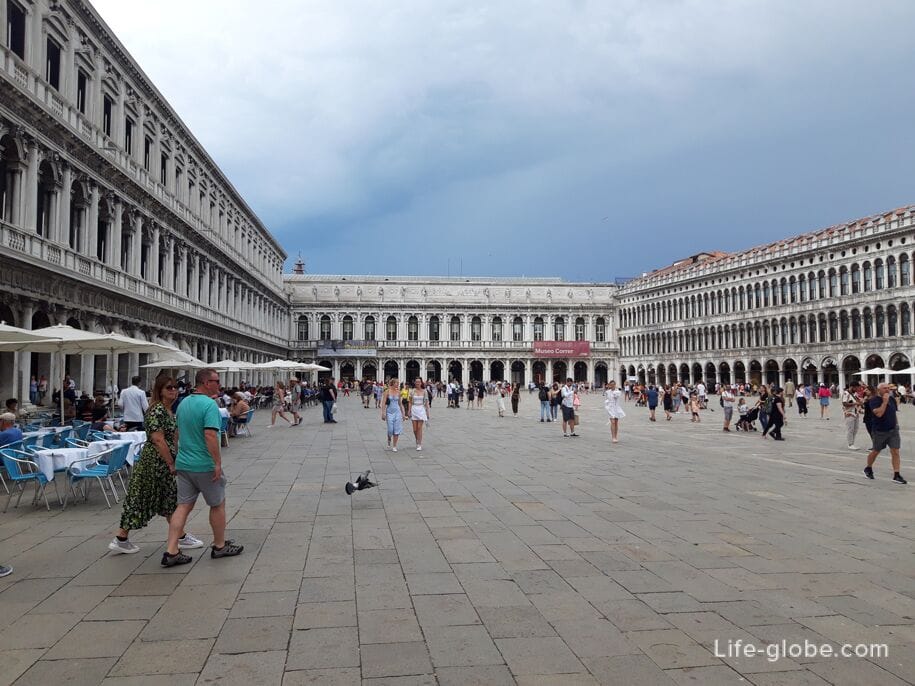
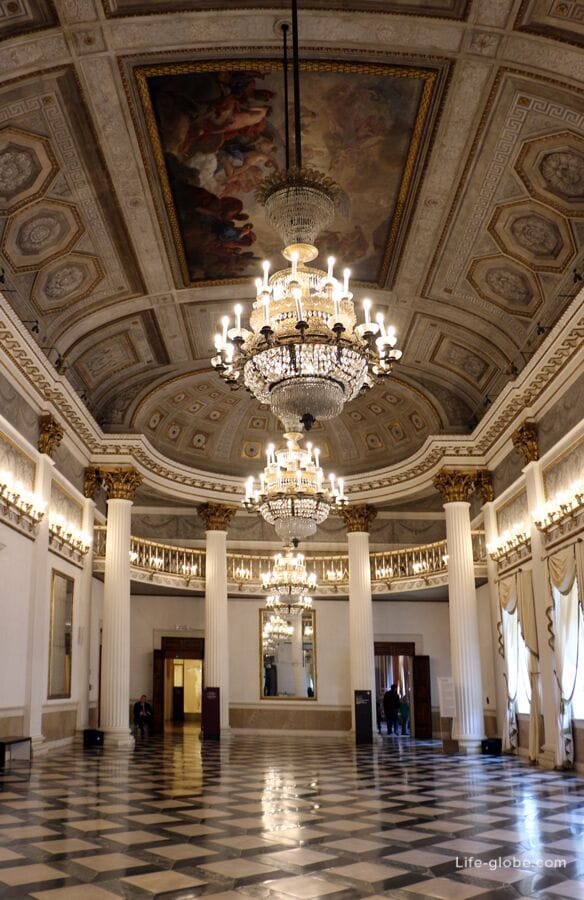
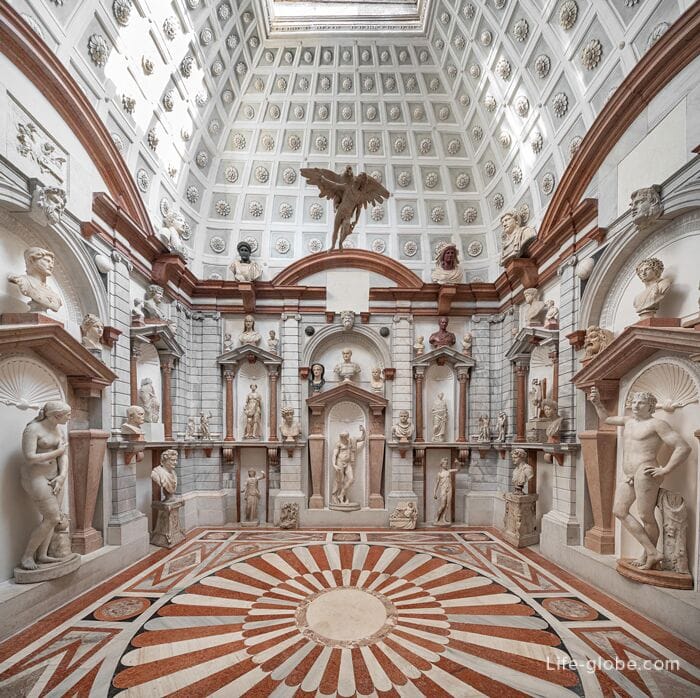
Slavyanskaya embankment
Slavyanskaya Embankment (Riva degli Schiavoni, Riva degli Schiavoni) is a coastal street, the most beautiful, wide and popular embankment in Venice.
The Schiavoni embankment runs along the St. Mark's Basin and consists of sections connected by pedestrian bridges over the Venetian canals.
The embankment is famous for palaces, architectural monuments and the monument to Victor Immanuel II. More about Slavyanskaya Embankment...

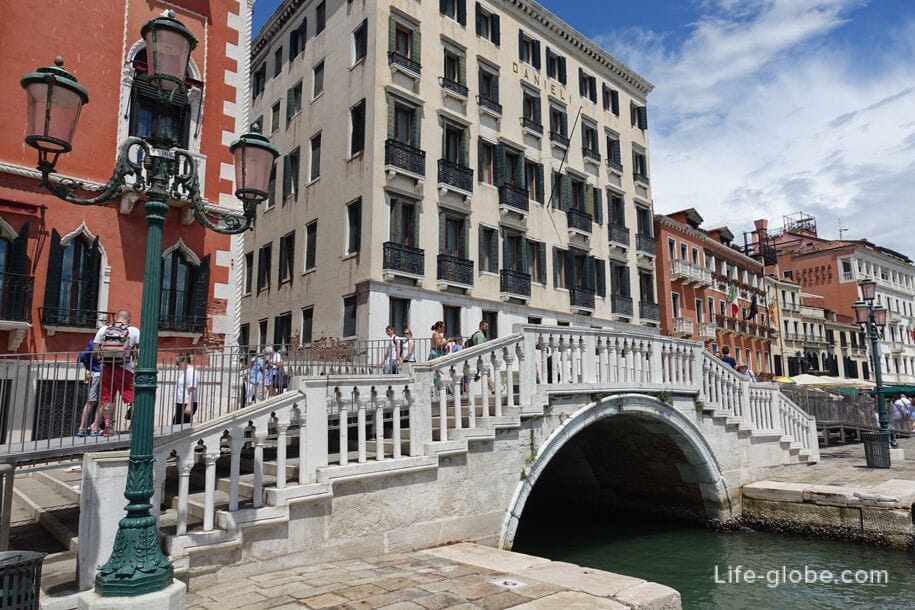
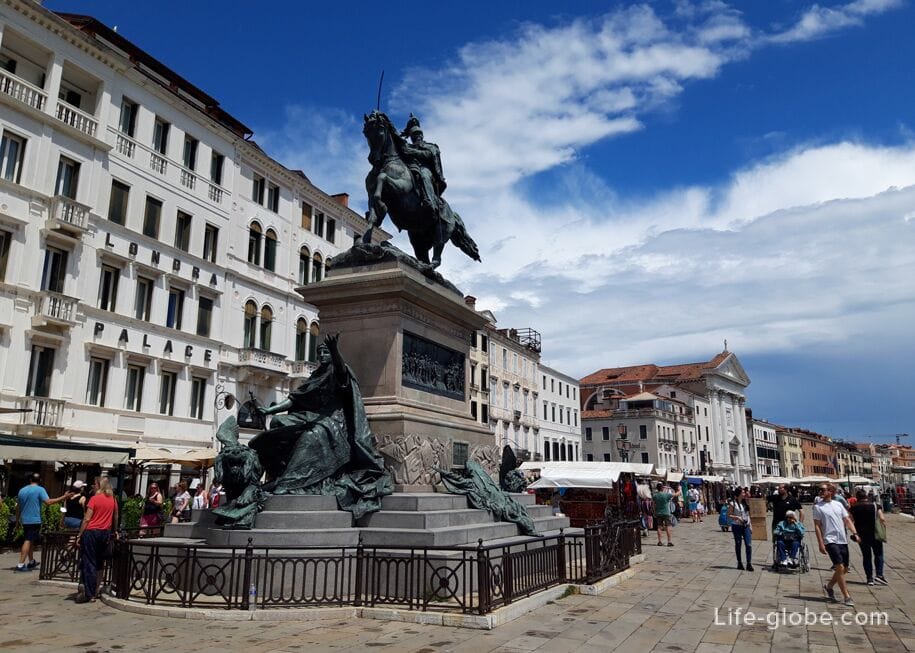
Fenice Theater
The Teatro La Fenice (La Fenice) is the famous opera house of Venice, which is one of the most famous in the history of the Italian opera house as a whole.
Its name "Phoenix" is connected with the history as "phoenix, risen from the ashes", the theater burned three times (in 1774, 1836 and 1996) and was revived again and again.
After the last fire, the theater was rebuilt in the style of the 19th century by architect Aldo Rossi, who, to recreate the historical details of the theater's design, used photographs from the first scenes of Luchino Visconti's film "Feeling" (1954), which was filmed in the theater.
The interior of the theater is notable for its magnificent foyer, ballroom and concert hall with a royal box, which has decorations in the form of gold, mirrors, stucco and murals.
The theater hosts operas and concerts; there is a permanent exhibition dedicated to Maria Callas and the years of her activity in Venice. Also, for a fee, the theater can be visited outside of the time of concerts and rehearsals.
Address of the Fenice Theater: Campo S. Fantin, 1965, 30124 Venezia VE, Italy.
Fenice Theater website: teatrolafenice.it .



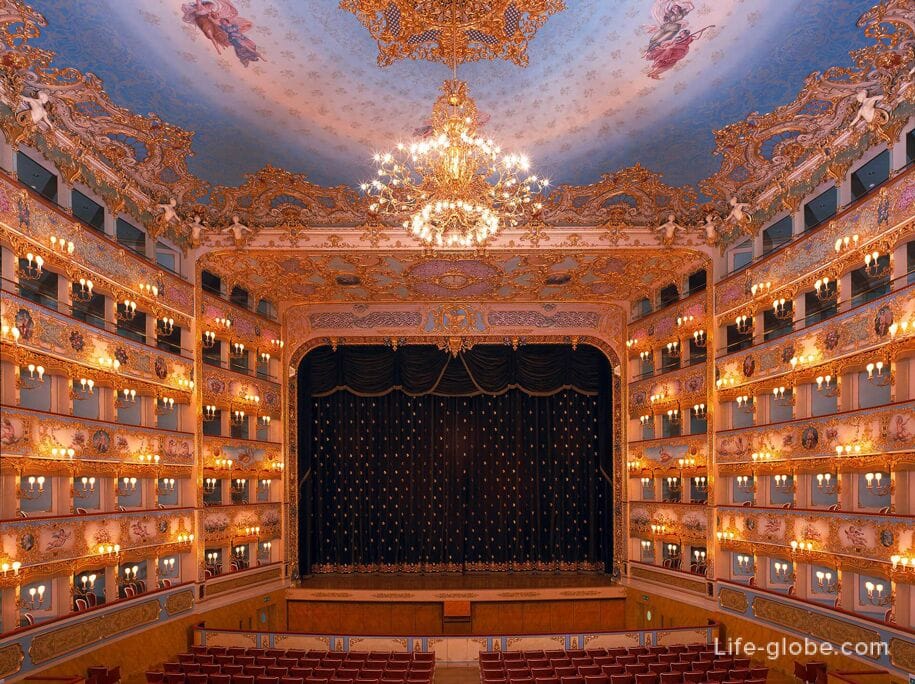
The Peggy Guggenheim Collection
The Peggy Guggenheim Collection (Collezione Peggy Guggenheim) is an art museum, most of the exposition of which is the personal collection of the 20th century American collector Peggy Guggenheim, which includes works by authors who worked in such areas as modernism, futurism, cubism, surrealism, abstract expressionism.
The museum presents works by Picasso, Leger, Severini, Mondrian, Kandinsky, Miro, Klee, Ernst, Magritte, Dali and other artists. The museum also displays paintings from the collection of Gianni Mattioli, including "Flowers" by the Italian painter Giorgio Morandi (1913) and "Portrait of the artist Frank Haviland" by the Italian artist Amedeo Modigliani (1914).
The collection is housed in the Palazzo Venier dei Leoni, which has an internal garden with sculptures.
Temporary exhibitions are held in the museum.
Entrance to the museum is paid.
Address of the Peggy Guggenheim collection: Dorsoduro, 701-704, 30123 Venezia VE, Italy.
Peggy Guggenheim Collection Website: guggenheim-venice.it.

Academy Gallery
The Academy Gallery (Gallerie dell'Accademia) is an art museum that is famous for Venetian art.
The architectural complex, which today houses the Large Galleries of the Academy, consists of several historical buildings: the former church of Santa Maria della Carit (Chiesa di Santa Maria della Carit), its monastery and the spaces of the eponymous Scuola Grande.
The Academy Gallery is the largest art museum in Venice, which houses the largest collection of paintings by artists of the Venetian school of painting who worked in the 14th and 19th centuries.
Among the main artists represented in the gallery are Tintoretto, Giambattista Pittoni, Titian, Canaletto, Giorgione, Giovanni Bellini, Vittore Carpaccio, Cima da Conegliano and Veronese.
The museum also houses other art forms, such as sculptures, plaster casts and graphics, including Leonardo da Vinci's famous "Vitruvian Man", which is exhibited only on special occasions.
Entrance to the gallery is paid.
Address of the Academy Gallery: Campo della Carita, 1050, 30123 Venezia VE, Italy.
Academy Gallery Website: gallerieaccademia.it. Learn more about the Academy Gallery...
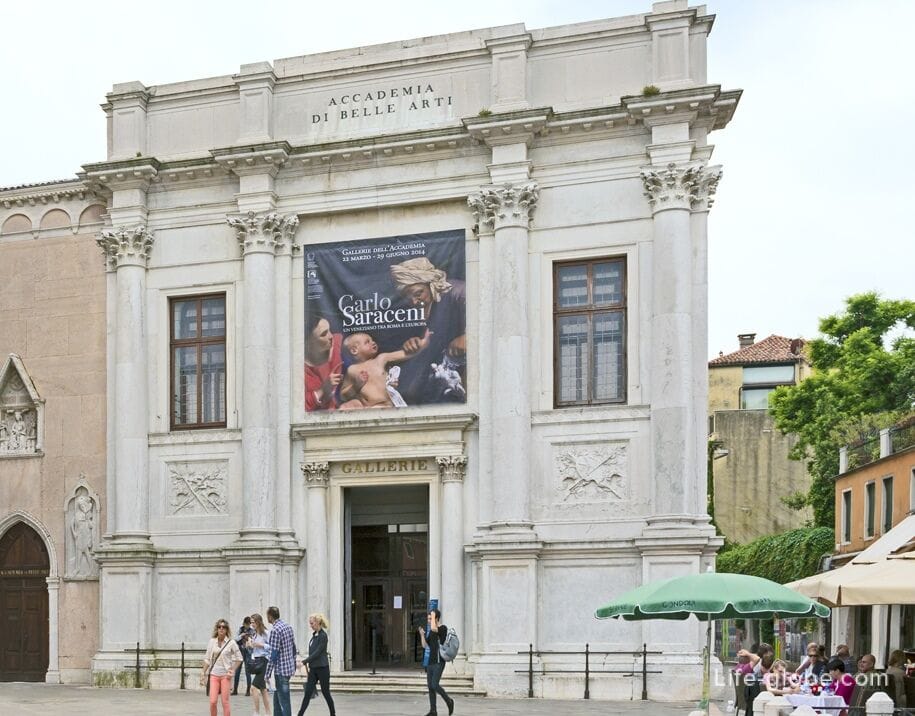
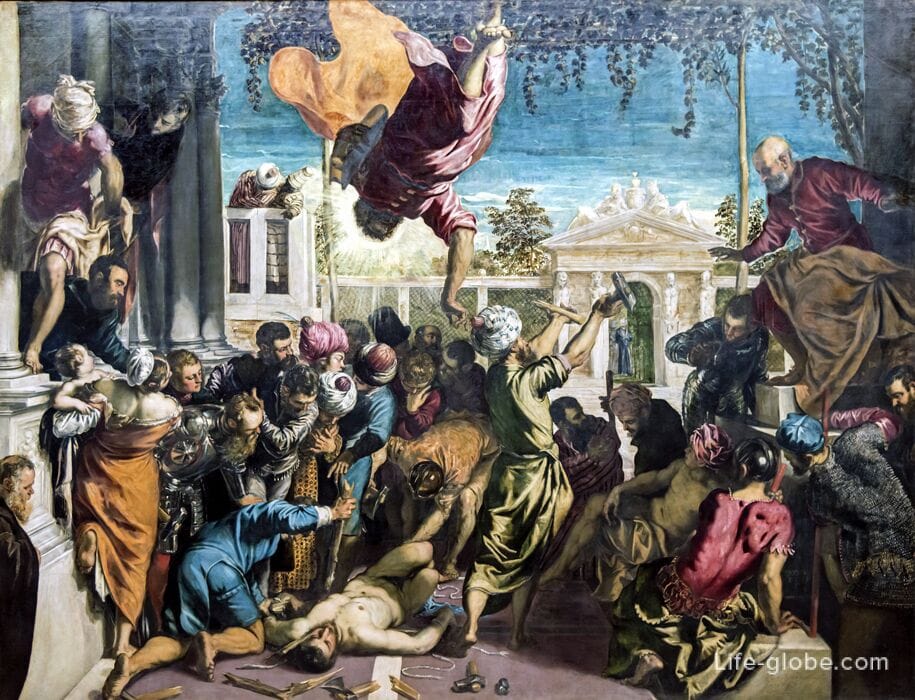
Basilica of Santa Maria Gloriosa dei Frari
Santa Maria Gloriosa dei Frari (Basilica di Santa Maria Gloriosa dei Frari, Basilica for the Glory of St. Mary from the brothers) is a church (cathedral) that has the status of a minor basilica and is dedicated to the Assumption of the Blessed Virgin Mary.
The history of the birth of the church began in 1231 and today it is one of the most important and largest in Venice.
Now it is also a museum and a place where concerts are regularly held.
The Basilica has mostly retained its Venetian Gothic look, and its interior is notable for the majestic monuments of outstanding Venetians, including paintings and as the resting place of Titian, Antonio Canova and a number of doges.
Entrance to the cathedral is paid.
The address of the Frari Basilica is: San Polo, 3072, 30125 Venezia VE, Italy.
Frari Basilica website: basilicadeifrari.it. More about the Basilica of Santa Maria Gloriosa dei Frari...
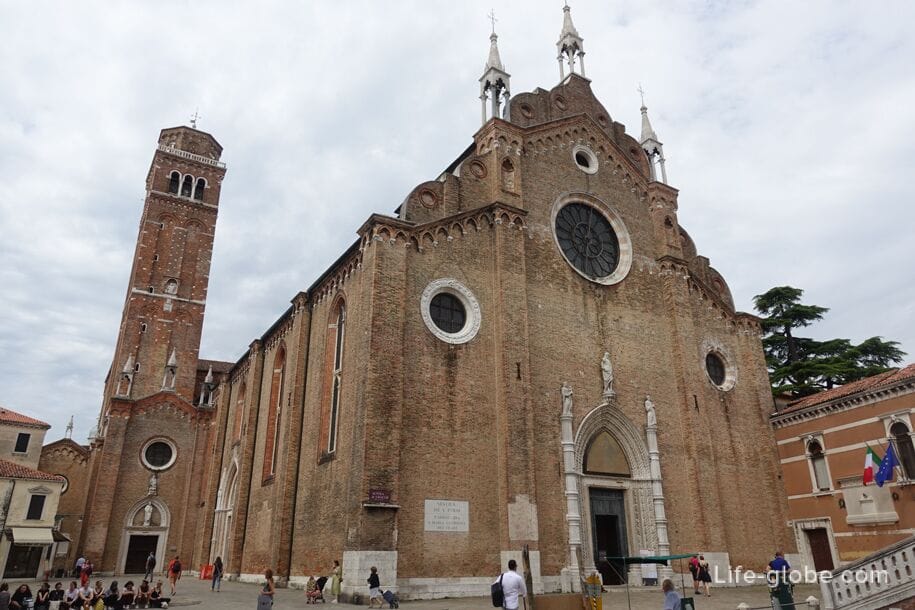
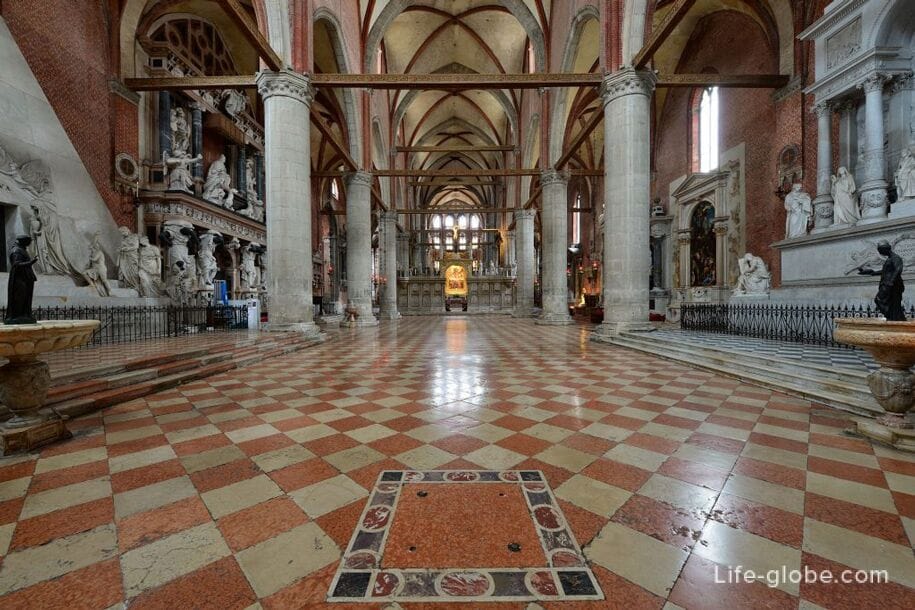
San Rocco Complex
San Rocco is the residence of the Abbey of St. Roch (Rocca) in Venice.
Among the people, San Rocco is considered a defender against the plague, and he is, along with St. Mark, the patron saint of Venice.
San Rocco is a complex of ancient buildings (dating back to the end of the 15th century), consisting of the Scuola (fraternity school) of San Rocco and the Church of San Rocco, now museums.
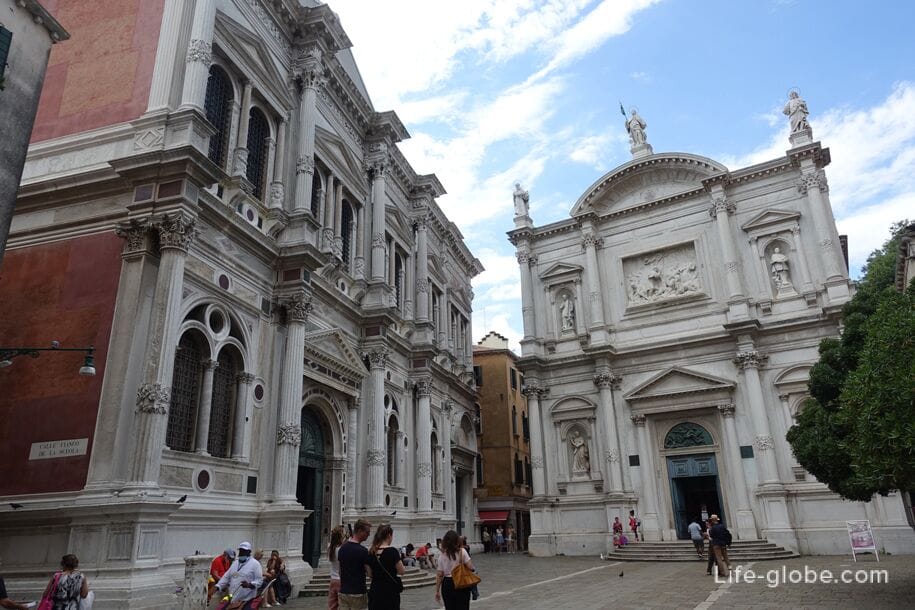
In the building of the scuola, you can visit the monumental staircase and halls decorated with frescoes and paintings telling about the Virgin, the life of Christ, saints, including Saint Rocha, biblical stories, mythology, as well as allegories of the seasons, human virtues and virtues. The works were carried out, including Tintoretto. Thus, today the Scuola San Rocco is the largest collection of Tintoretto paintings in the world, placed in halls on walls and ceilings. In addition, the collection of Scuola's masterpieces includes works by Titian, Giorgione, Antonio Zanki, Tiepolo, Pietro Negri and Giovanni Antonio Fumiani.
On the second floor of the Scuola is the Treasury of the Scuola San Rocco, which is furnished with large cabinets of the eighteenth century, which store items intended for religious worship.
There is also a collection of unique ceramics in the school, and temporary exhibitions are held.
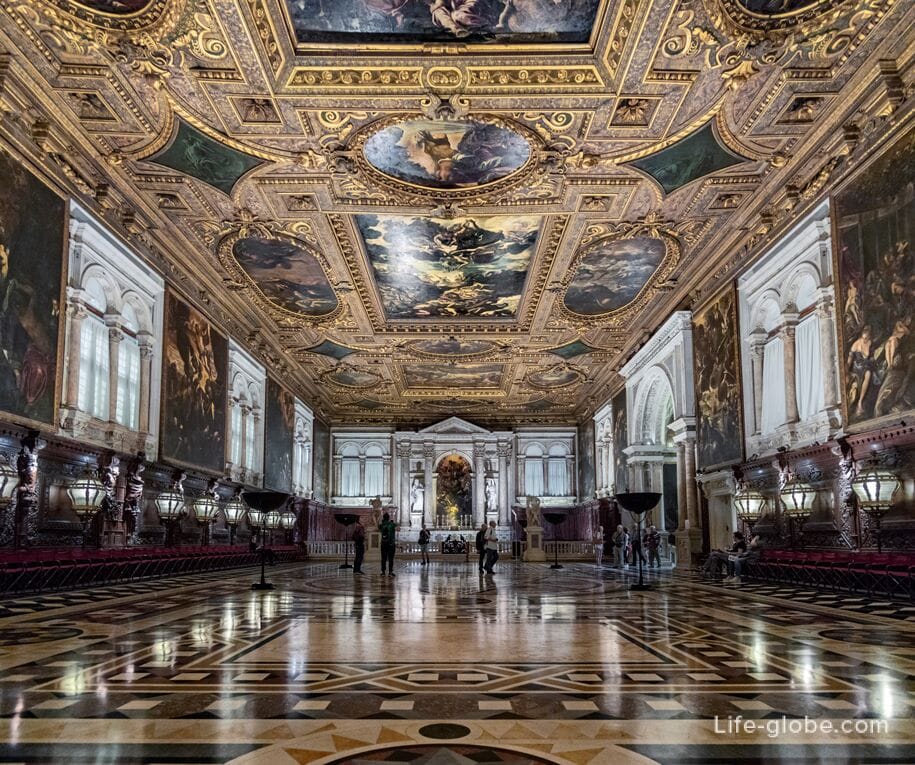
In the nearby church of San Rocco are the relics of St. Roch.
The church is notable for statues by Giovanni Marchiori, Giovanni Maria Mosca and Bartolomeo Bergamasco, as well as frescoes and paintings, including works by Tintoretto.
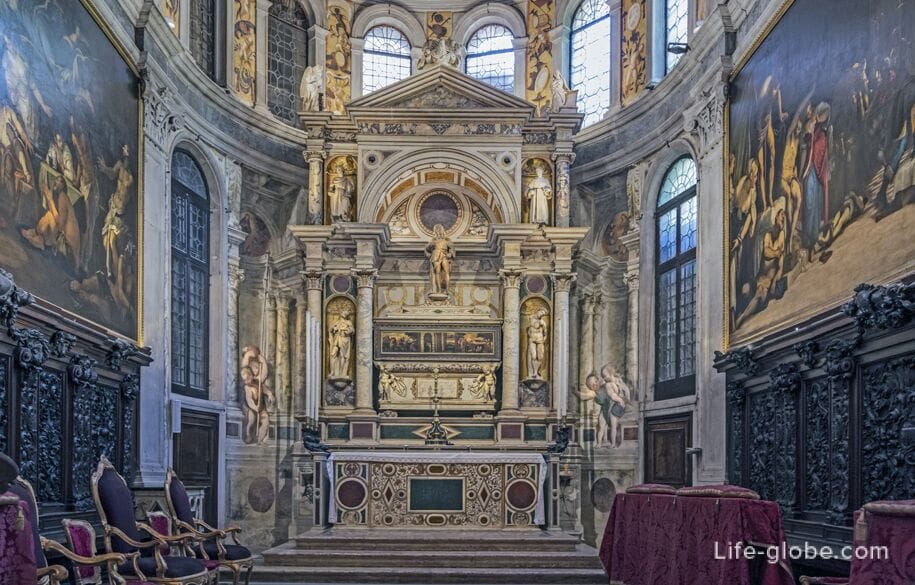
Visits to the Scuola of San Rocco and the Church of San Rocco are paid.
Address of the San Rocco complex: Campo S. Rocco, 30125 Venezia VE, Italy.
San Rocco website: scuolagrandesanrocco.org. More about the San Rocco complex...
Basilica of Santi Giovanni e Paolo
The Basilica of Santi Giovanni e Paolo, also known as San Zanipolo (Basilica dei Santi Giovanni e Paolo, San Zanipolo) is a magnificent huge Gothic church (cathedral), which is one of the most impressive medieval and religious buildings in Venice.
The history of the church begins in 1234, when Doge Jacopo Tiepolo dreamed of a swampy area full of wonderful flowers, over which white doves and singing angels flew. The next day, the Doge reported his dream to the Senate, and the Doge managed to give the Dominicans a place that appeared in his dream, where a basilica dedicated to the 5th century Romanian martyrs Giovanni and Paolo (John and Paul) was then erected.
The consecration of the church took place on November 14, 1430.
Today it is one of the largest churches in Venice with a magnificent Italian Gothic style.
Next to the church is an equestrian statue of the condottiero Bartolomeo Colleoni (1483) by Andrea del Verrocchio.
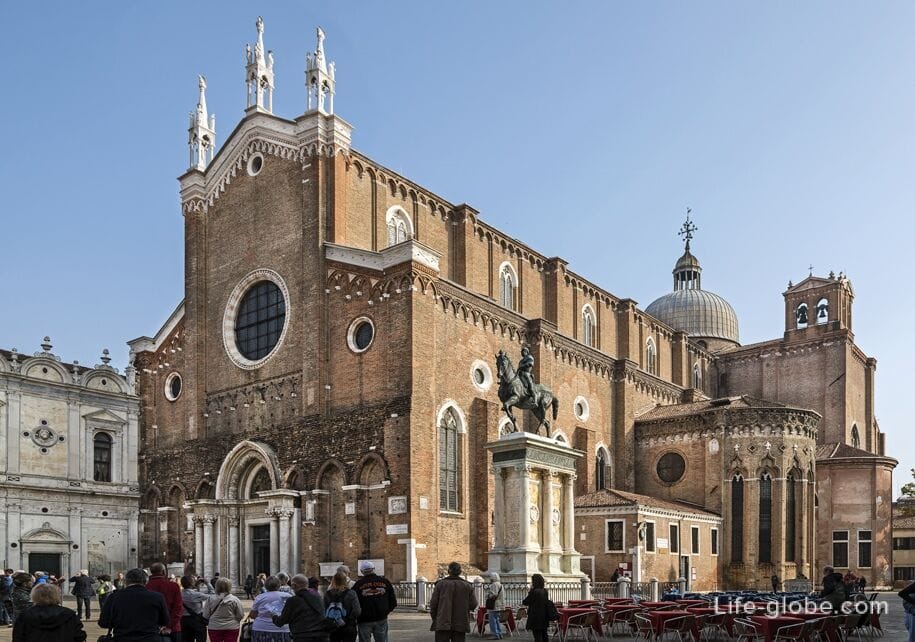
During the history of such a significant shrine, state celebrations and memorial services of the Doge of Venice were held. As a result, the voluminous interior of the basilica with powerful columns has monumental tombs, paintings and sculptures created by famous Venetian masters, among whom Bellini, Cima da Conegliano, Palma il Giovane, Vivarini and Veronese are noted.
Because of the large number of tombstones, the basilica is called the Pantheon of Venice. At least 150 tombstones and 37 monumental tombs have been preserved inside the basilica, 25 of which are dedicated to the Doge of the Most Serene from the thirteenth to the eighteenth centuries.
The most striking and greatest masterpiece of the basilica is a sculptural monument dedicated to the influential Doge Pietro Mocenigo by Pietro Lombardo (1382). Also stand out: the monument to Doge Leonardo Loredan (1521), Doge Andrea Vendramin (1478) and Doge Sebastiano Venier, the main hero of the famous victory in the Battle of Lepanto (1571); the monument to Doge Jacopo Tiepolo, the founder of the basilica, and the most majestic monument belonging to the Valle family.
Among the outstanding people who rest in the walls of the basilica are Giovanni and Gentile Bellini (two of the most famous Venetian artists) and the Bandiera brothers, patriots and the main characters of the Italian Risorgimento.
In the right part of the nave there is an urn with the ashes of the protagonist of the military history of Venice, Marcantonio Bragadin, who was imprisoned and killed alive after enduring the Turkish siege of Famagosta on the island of Cyprus for several months.
Among the works of art, the paintings of Giovanni Bellini and Veronese stand out.
Also, the basilica is currently the only basilica with the largest Gothic and polychrome stained glass in Venice, created entirely from Murano glass by the master glassblower Giannantonio Licinio da Lodi in the 16th century, probably based on the caricatures of Bartolomeo di Vivarini.
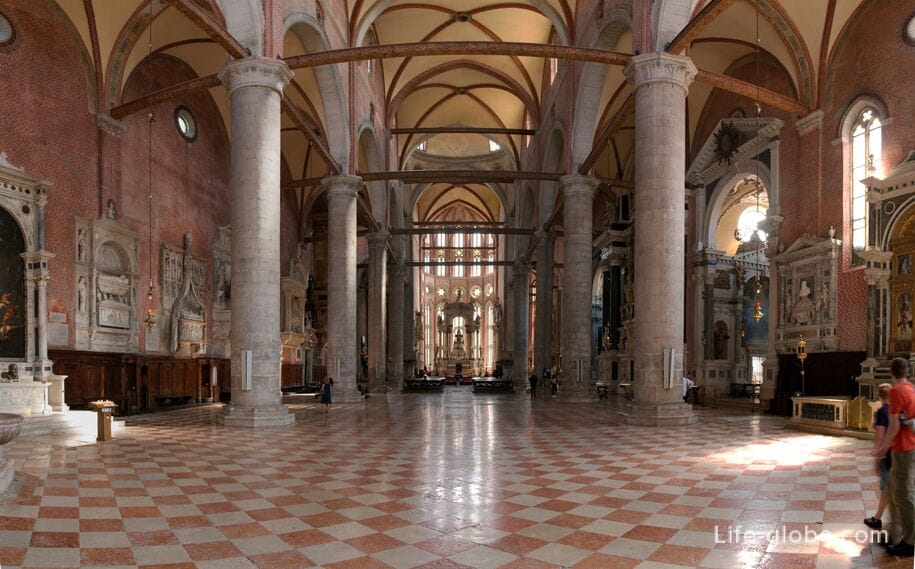

A visit to the basilica is paid, for a recommended donation.
The address of the Basilica of San Zanipolo: Campo SS. Giovanni e Paolo Castello 6363, 30122 Venezia, Italy.
The website of the Basilica of San Zanipolo: santigiovanniepaolo.it.
Venice Arsenal and Venice Naval History Museum
The Arsenal of Venice or the Venetian Arsenal (Arsenale di Venezia) is a historical complex of shipyards and workshops, thanks to which the Republic of Venice could fight the Ottomans in the Aegean Sea, and conquer the routes of Europe.
The history of the state shipyard dates back to the 12th century and subsequently underwent significant expansion, modernization and restoration.
Today, part of the arsenal can be visited. Exhibitions and various events are also held here. In historical buildings near the arsenal there is the Museum of Naval History of Venice (museo Storico Navale di Venezia) and the Church of San Biagio ai Forni (Chiesa di San Biagio Vescovo).
One of the most attractive parts of the Arsenal of Venice is the one that overlooks the Arsenal Canal of the same name, along which stretches a monumental battlemented wall leading to the main gate of the Venetian Arsenal, where there are arsenal towers and land gates with decorations and sculptures of lions.
Arsenal website: arsenaledivenezia.
The website of the Museum of the History of the Navy of Venice: museo-storico-navale-di-venezia. More about the arsenal, museum and church...
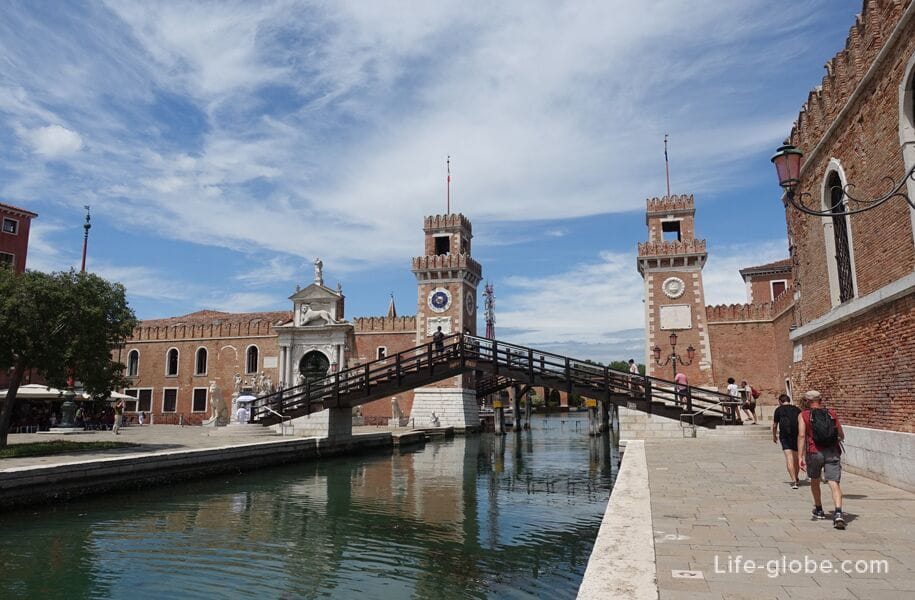
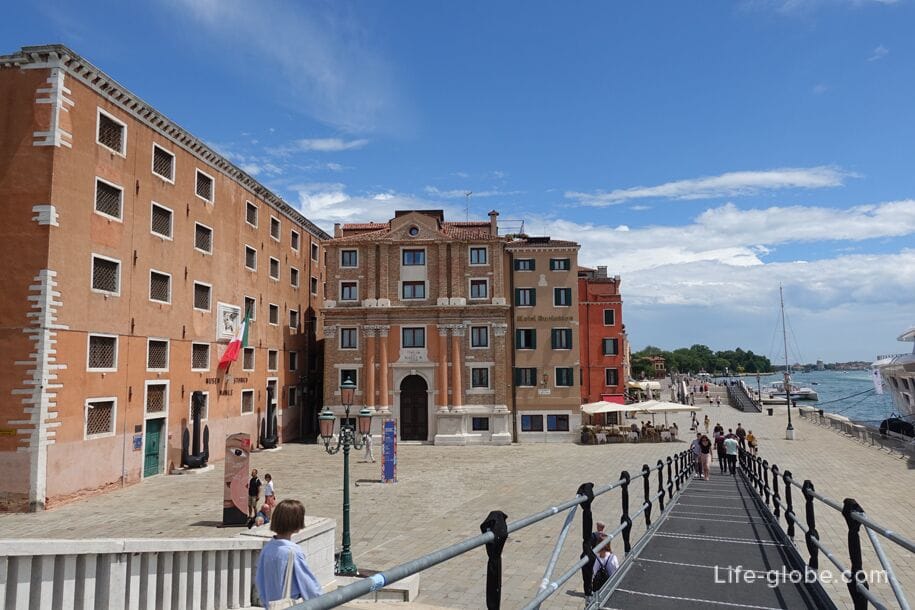
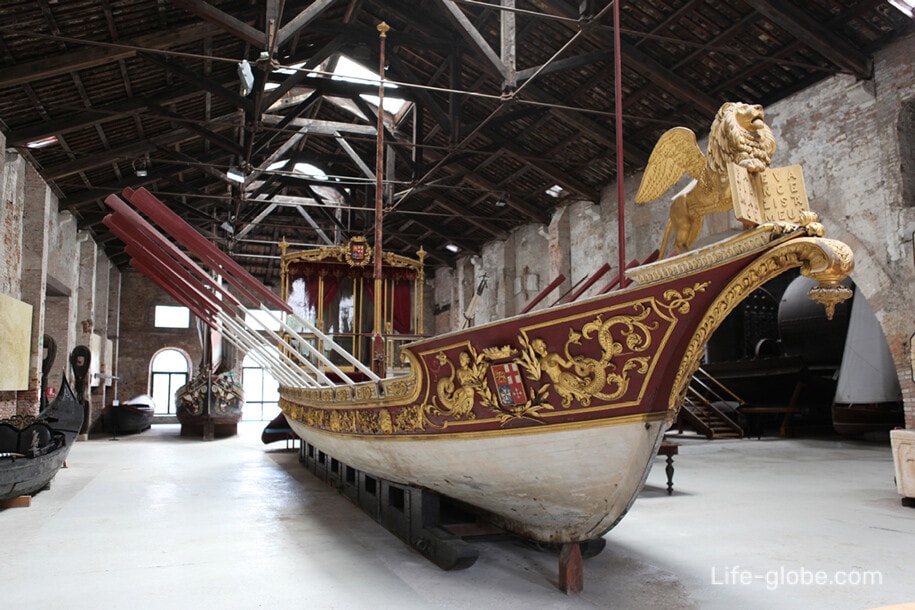
P.S.
The sights and museums of Venice listed in this article are quite enough for leisurely walks for 1-2 days, and if you go to museums, then even longer.
After visiting the main places of Venice, you can go to the rest of the sights of the city or, no less interesting, just wander and enjoy the labyrinths of narrow Venetian streets, in which it is easy to get lost and which are replaced by countless channels with small, sometimes seemingly toy bridges; while taking a few photos for memory, admire the facades of ancient buildings, in places significantly battered, wander into small squares, look into shops and boutiques. Feeling pleasantly tired, sit down in some small colorful restaurant for a leisurely meal, or maybe just have a cup of coffee with local sweetness, sitting at a table in the open air and watching the streams of tourists "rushing" back and forth. And then, take a river walk through the canals of Venice.
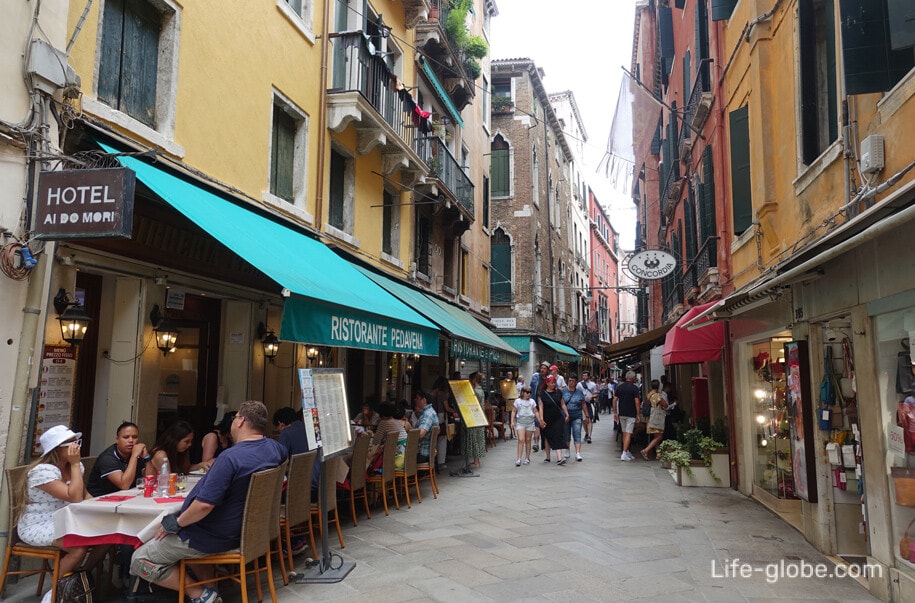

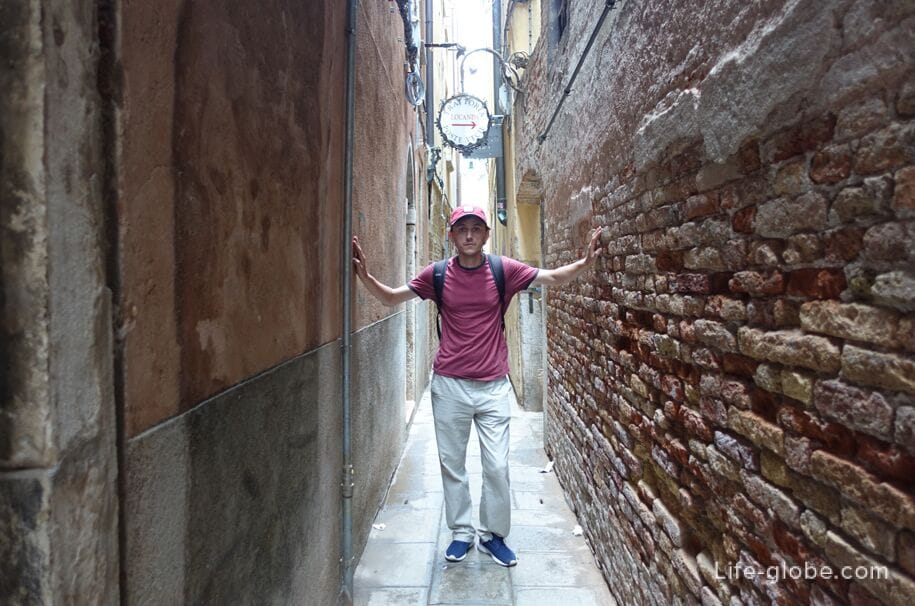
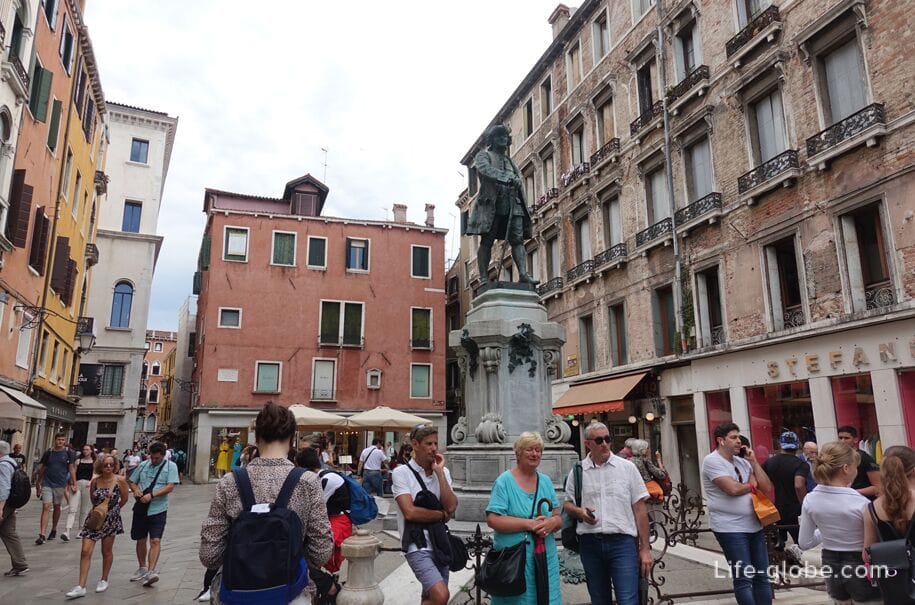
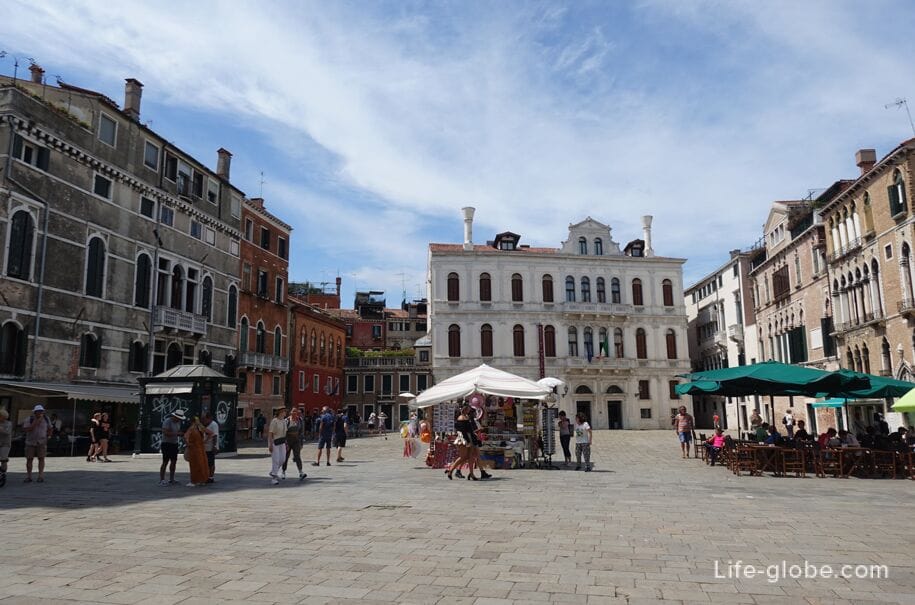
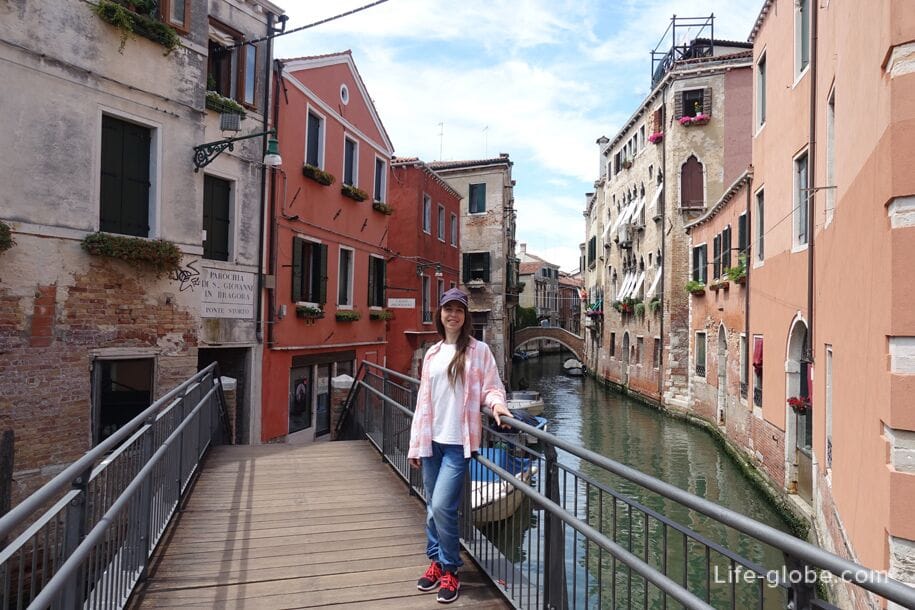
The most famous and visited place for walking with the purpose of shopping in the historic island of Venice is the Mercerie district, stretching from St. Mark's Square to the Rialto Bridge.
This commercial artery of Venice is an articulated complex of streets.
There are shops, boutiques and souvenir shops on the ground floors of the buildings surrounding the streets in dense rows. In Mercerie you can buy clothes, shoes, hats, designer items, jewelry, leather goods, antiques, Murano glass products and other goods, both local and world-class.

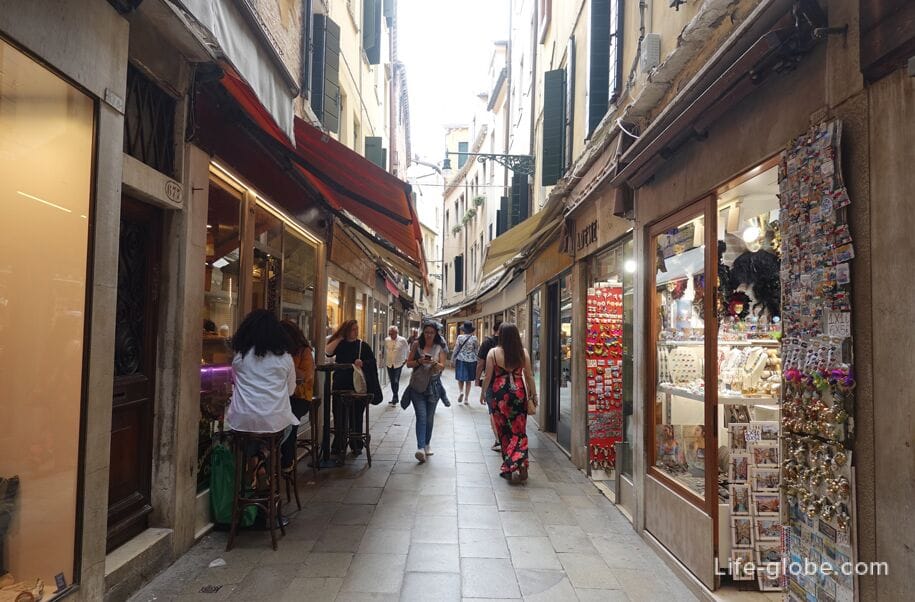
You can also, for example,
to walk and see the church that is recognized as the oldest in Venice is the Gothic church of St. Giacomo di Rialto (Chiesa di San Giacomo di Rialto), which is said to have appeared in the year of the foundation of Venice (421), and its current structure dates back to about 1071. The church is notable for the large 15th century clock on the facade;
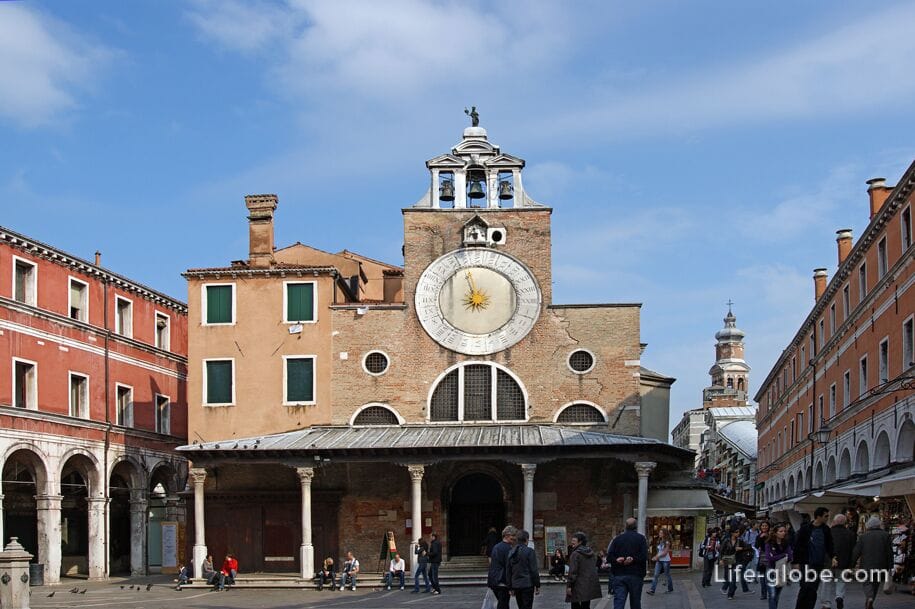
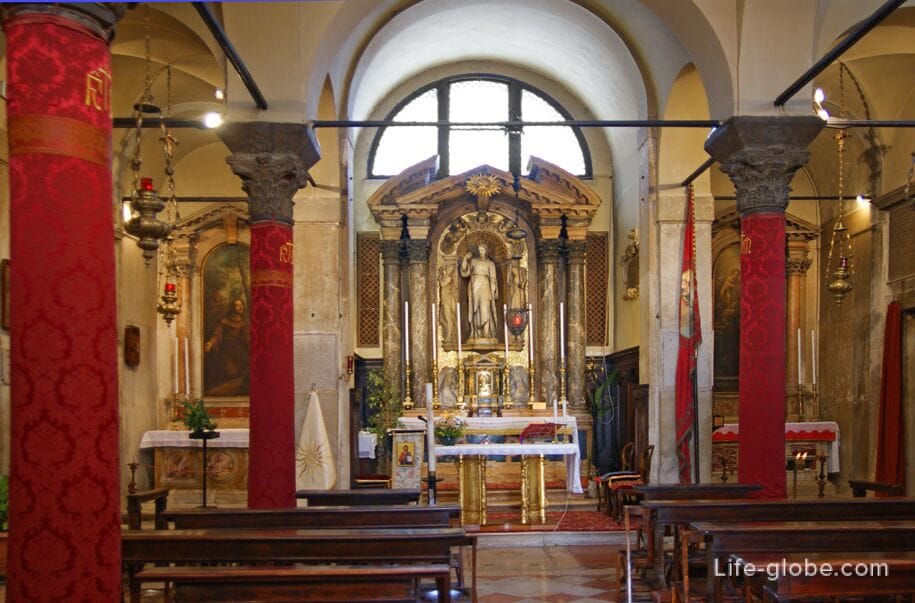
take a walk to the Palazzo Contarini del Bovolo (Scala Contarini del Bovolo) - a restored 15th-century palace, famous for its Gothic twisted staircase, in which the filming of Orson Welles' film Othello took place, and considered the secret place of Venice. For a fee (pre-registration is recommended) you can climb the stairs to the observation deck. Website: scala-contarini-del-bovolo;
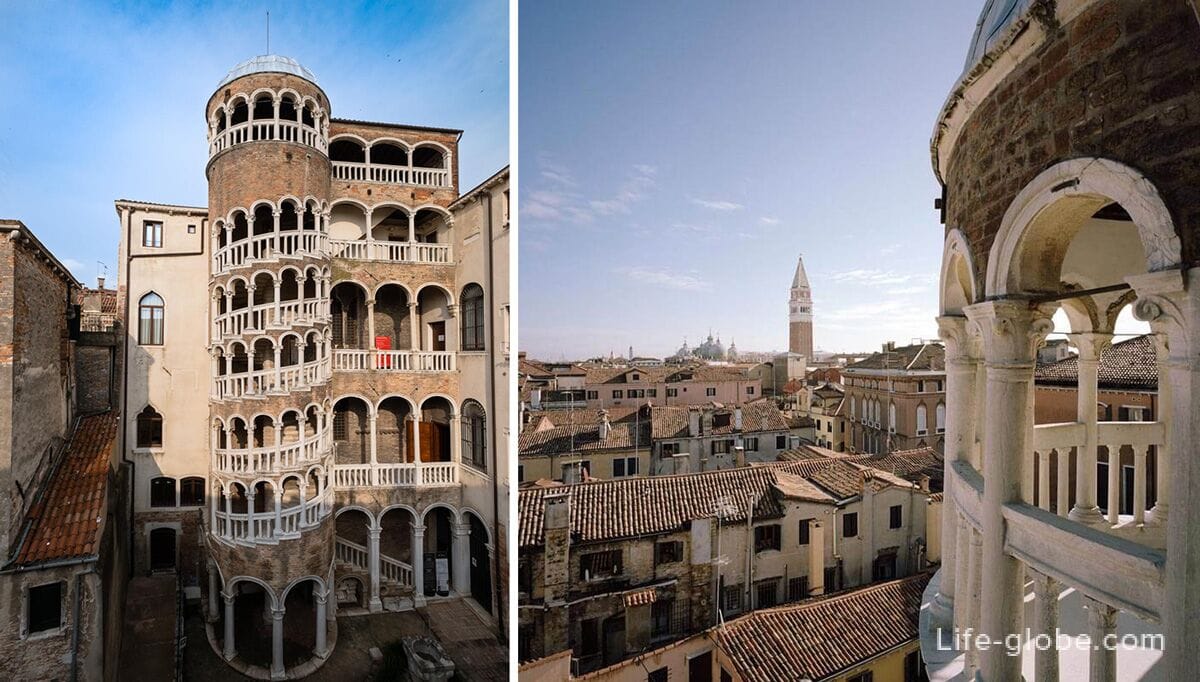
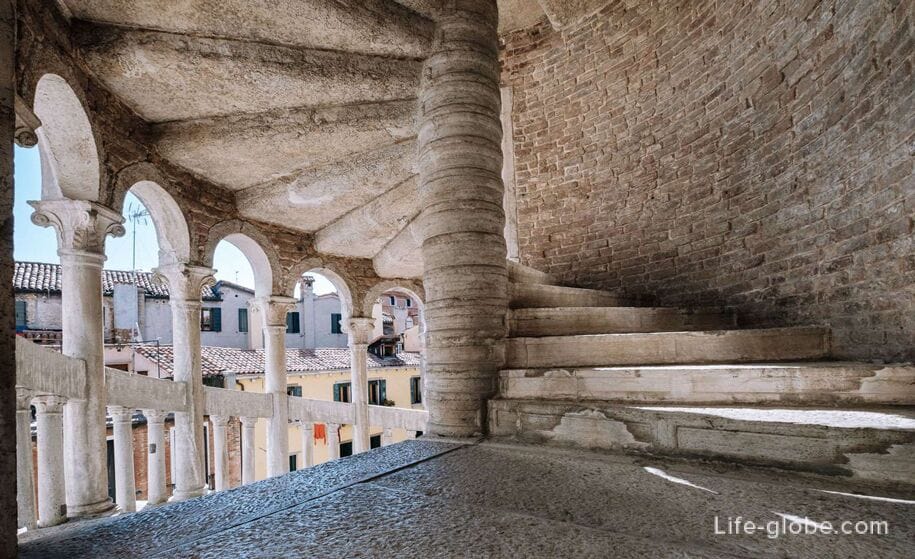
visit the Church of San Barnaba, where a museum with exhibitions of Leonardo da Vinci's inventions is open today (Museo Leonardo da Vinci Venezia- Chiesa di San Barnaba); the Church of San Maurizio, where the music museum is located (Museo della Musica di Venezia); the 16th-century Grimani Palace, where the Doge once lived Antonio Grimani, and now the Palazzo Grimani Museum with works of art and furniture (Museo di Palazzo Grimani).
If you have the time and desire, it will be a good addition to the rest to go (swim on the water) on the Venetian lagoon. For example, visit the island of San Giorgio Maggiore with the Basilica di San Giorgio Maggiore towering on it, which has an observation deck in the bell tower; or the colorful island parts of Murano and Burano.
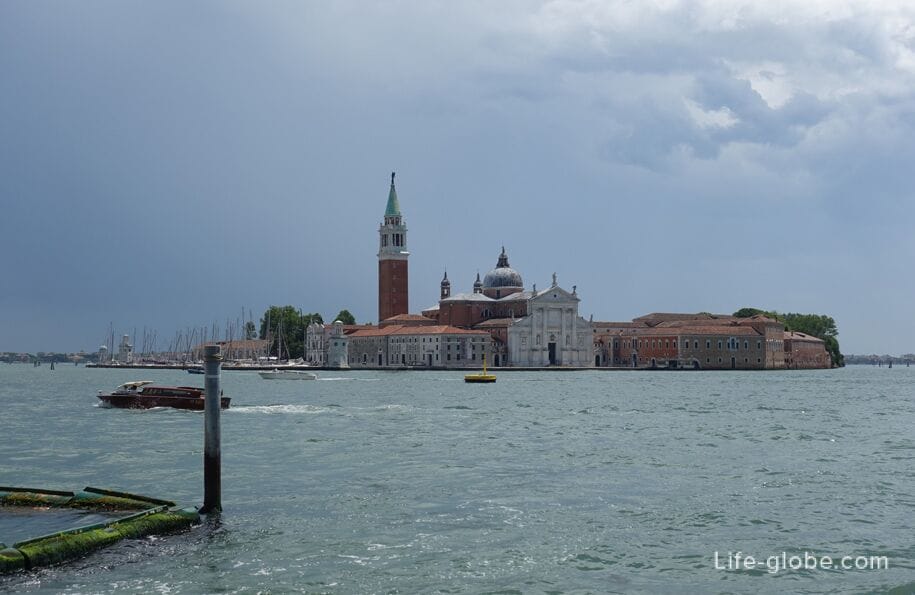

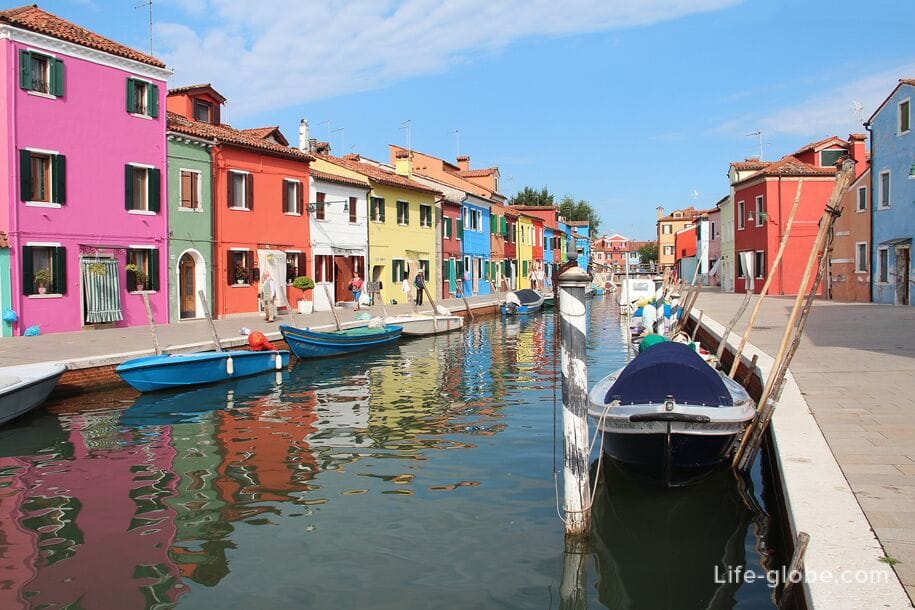
All accommodation facilities in Venice, including in the historical center of the city and more remotely from it, can be viewed and booked here




